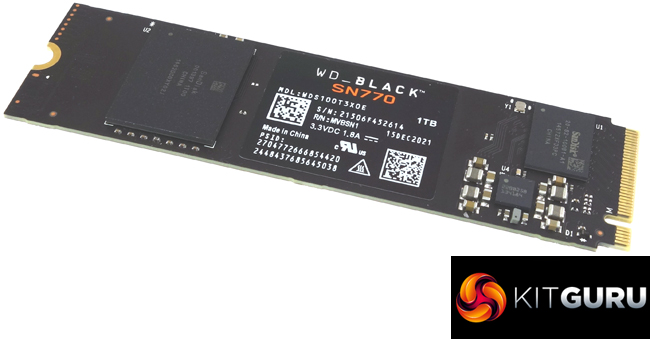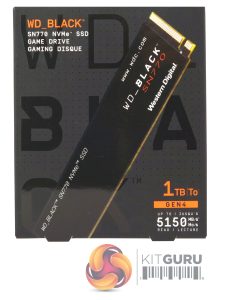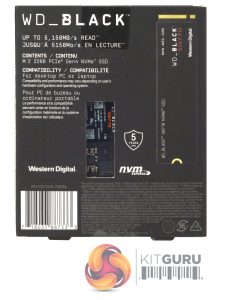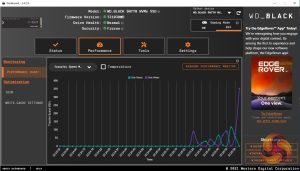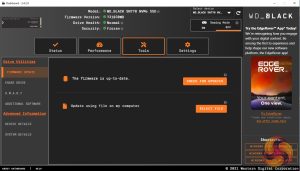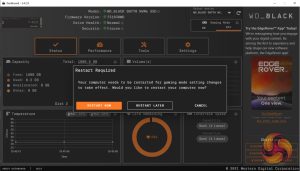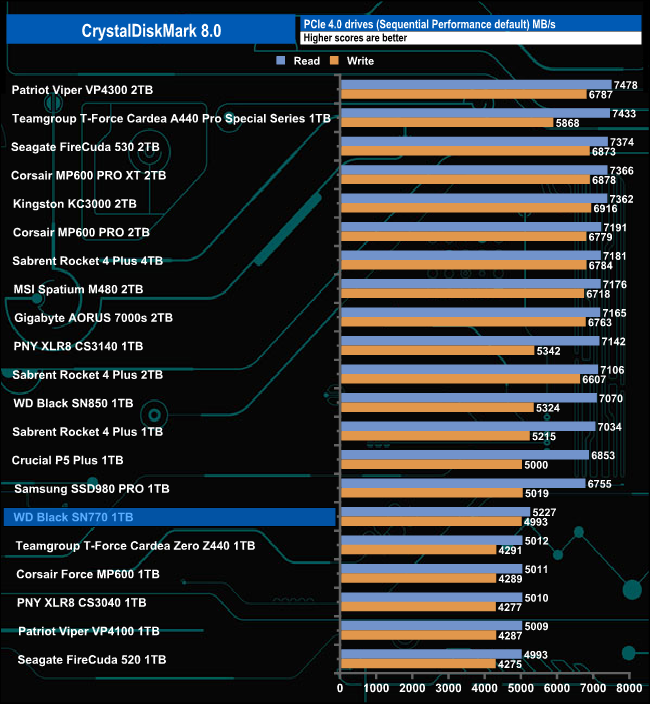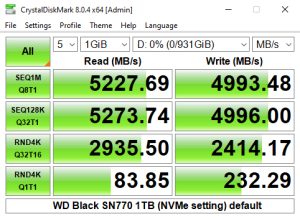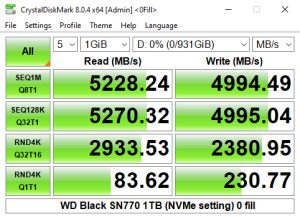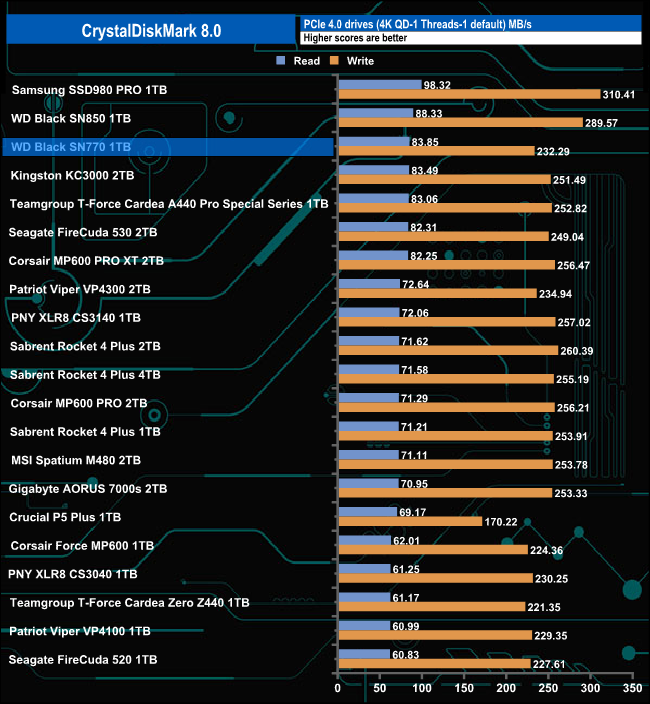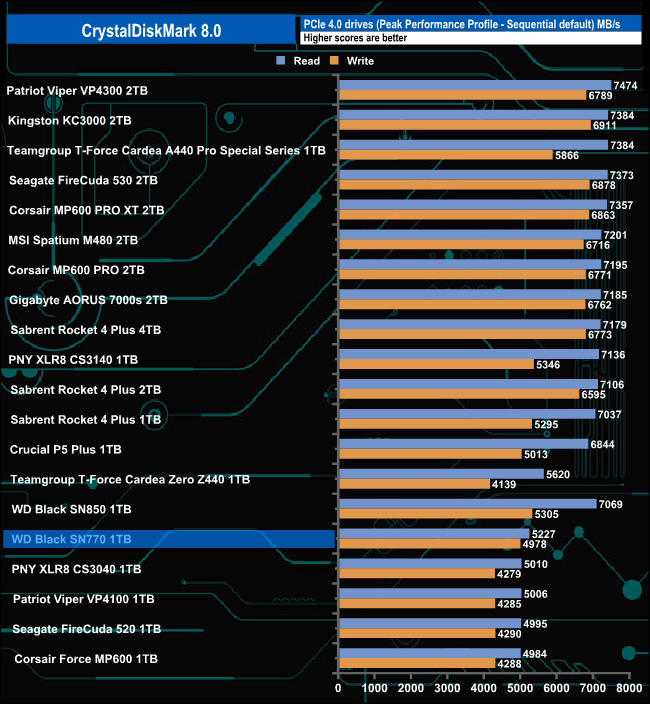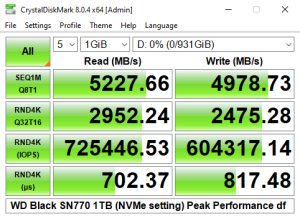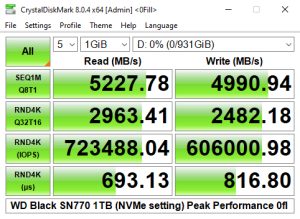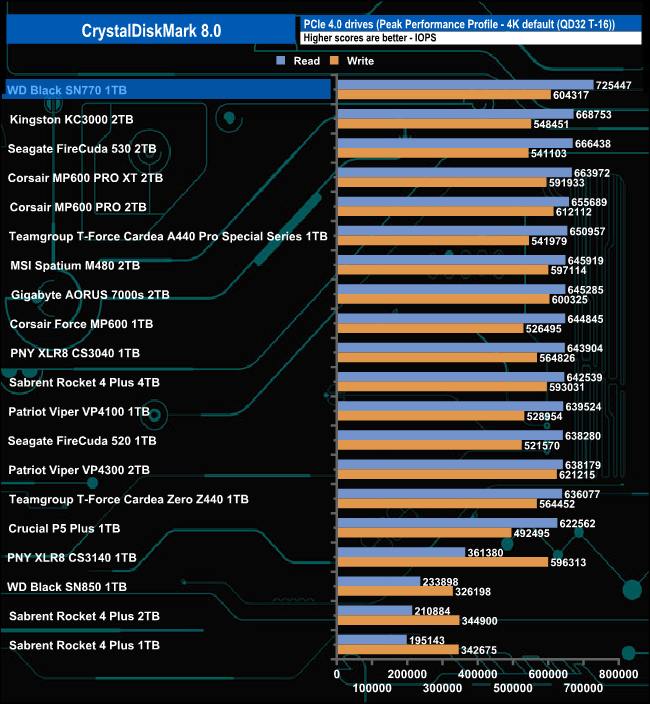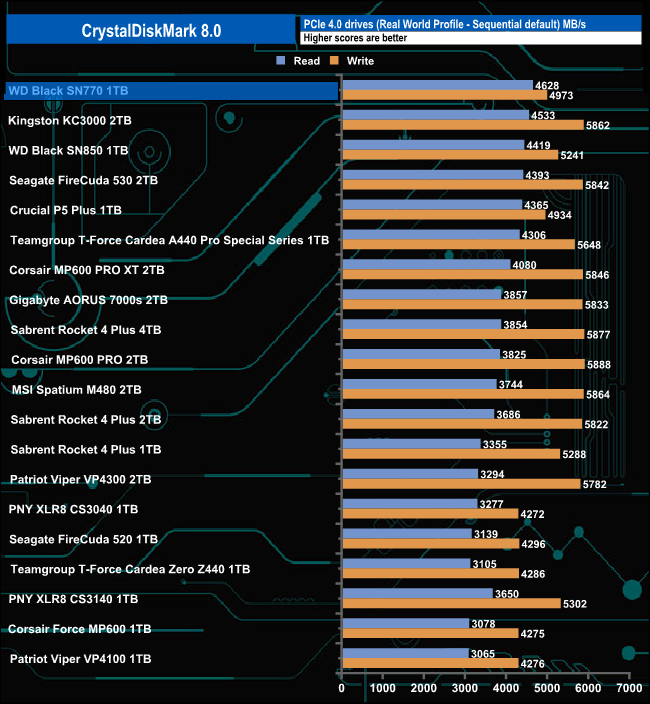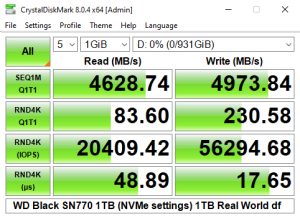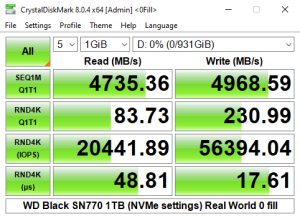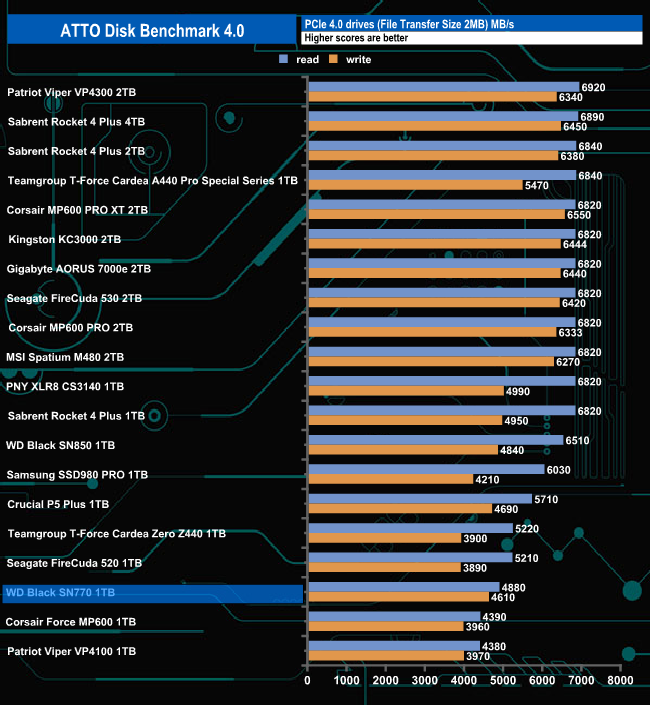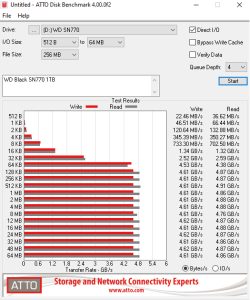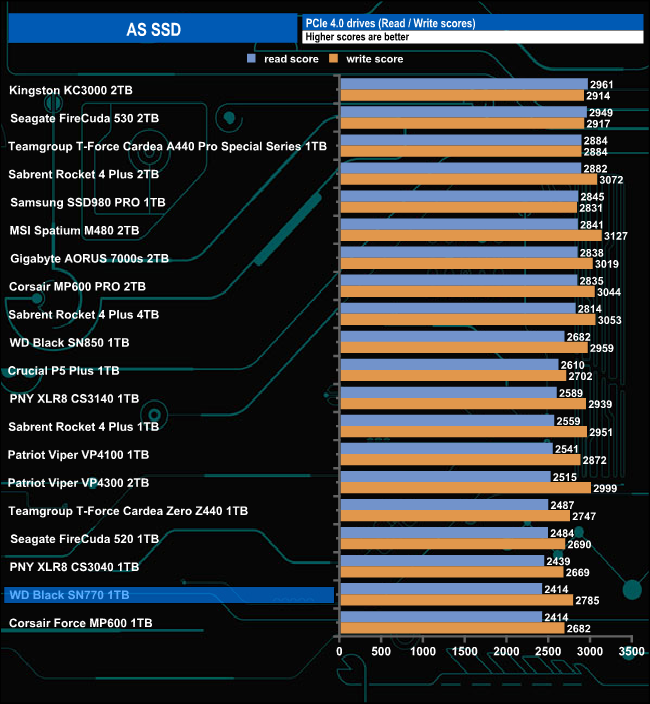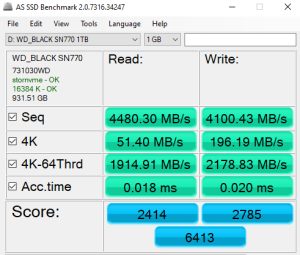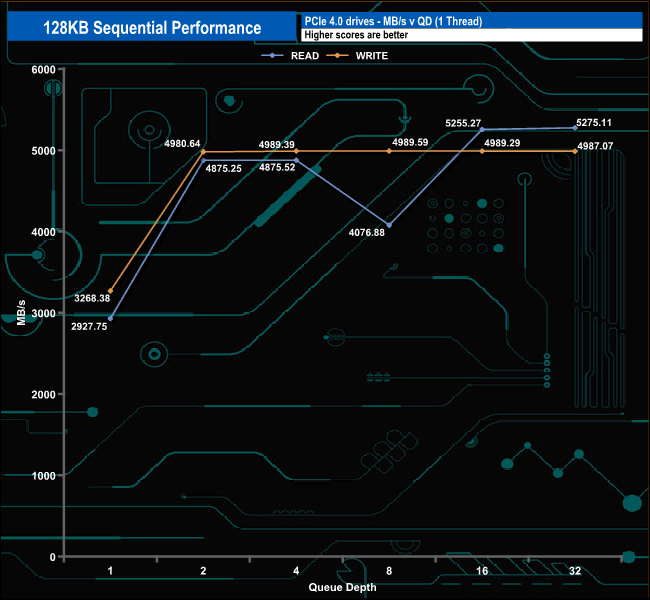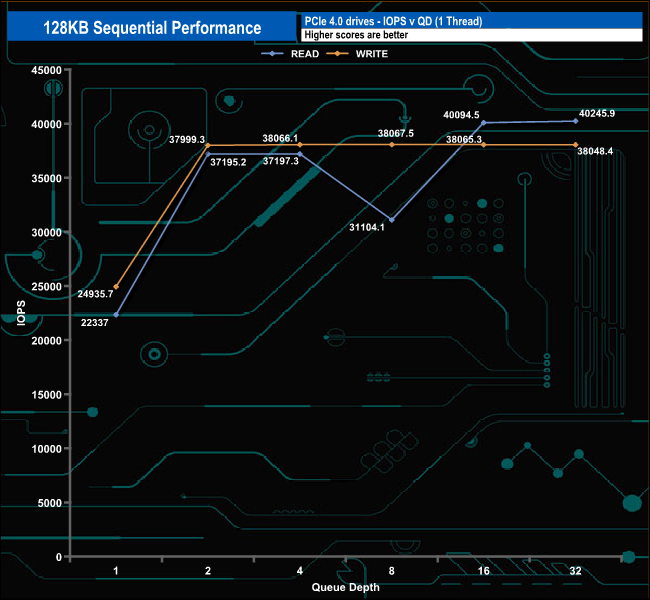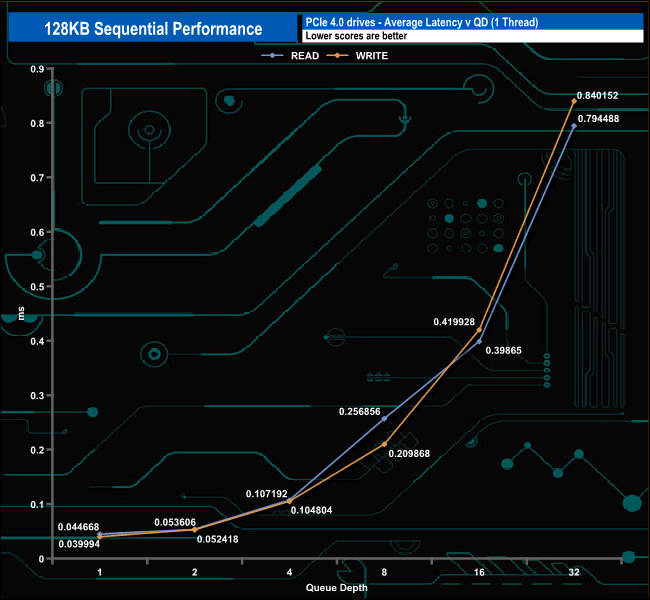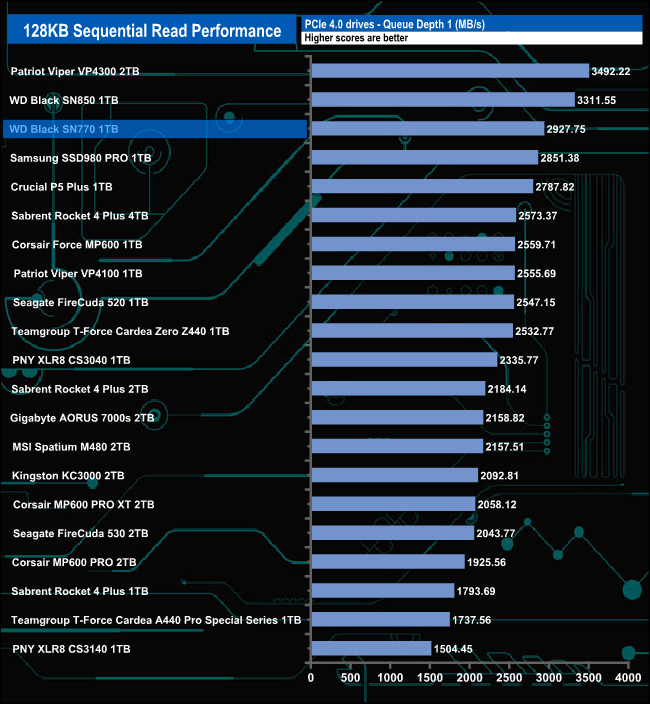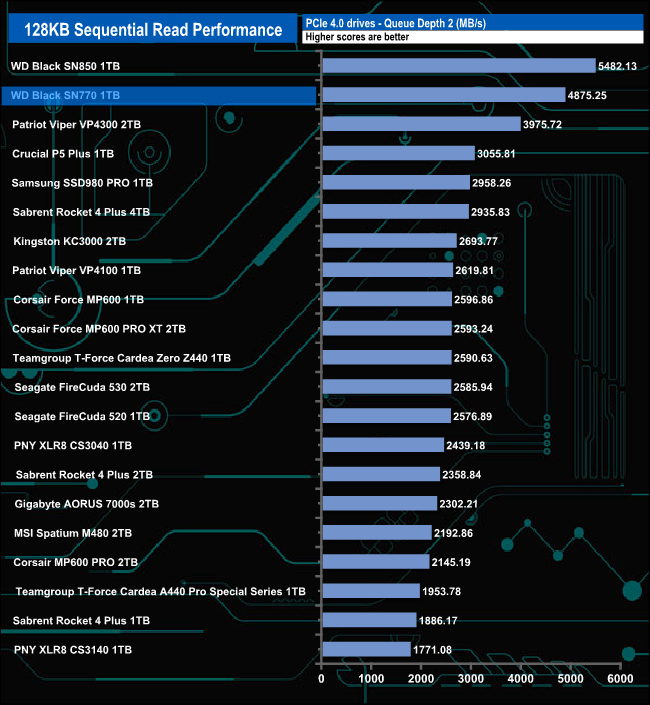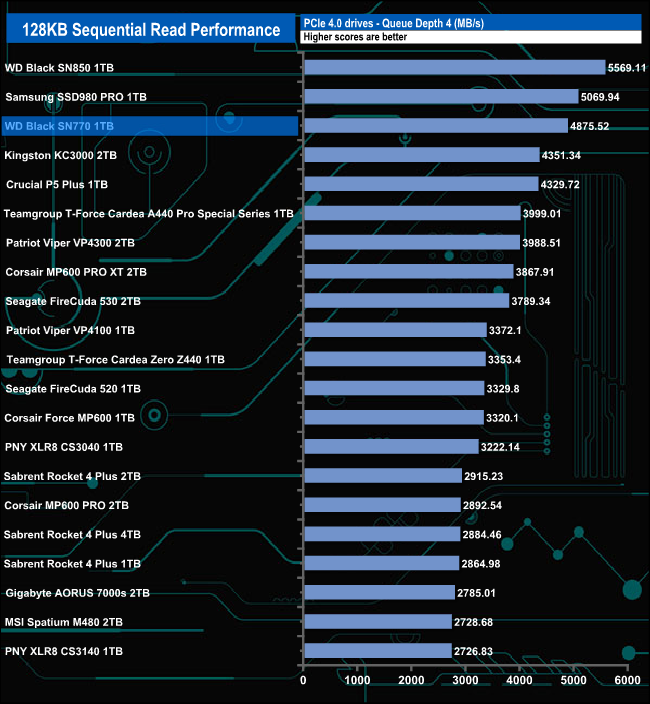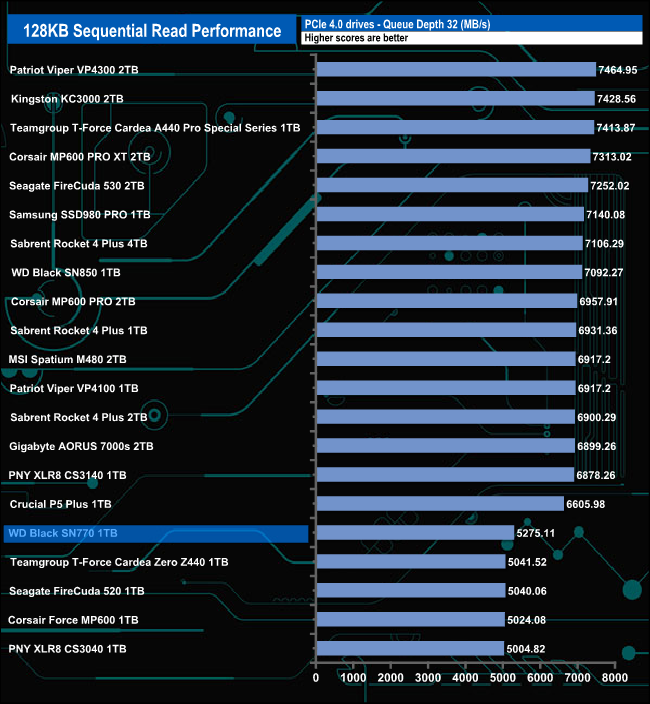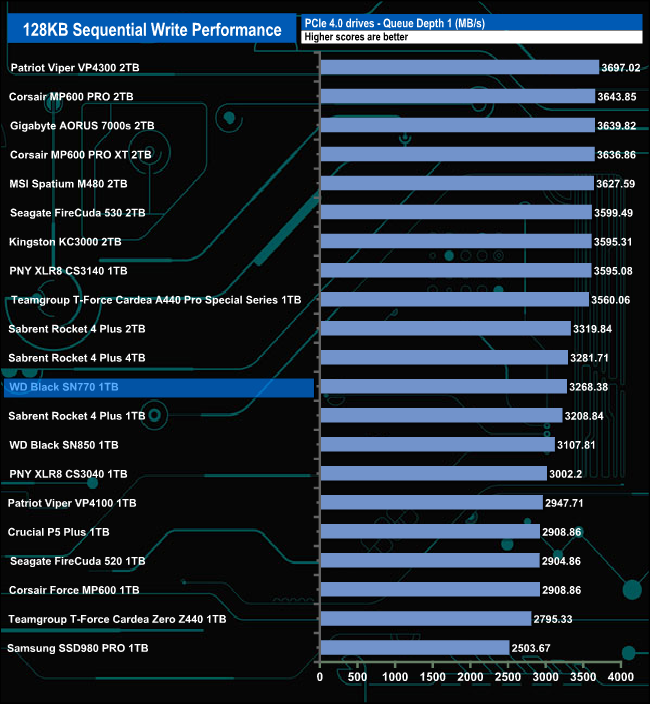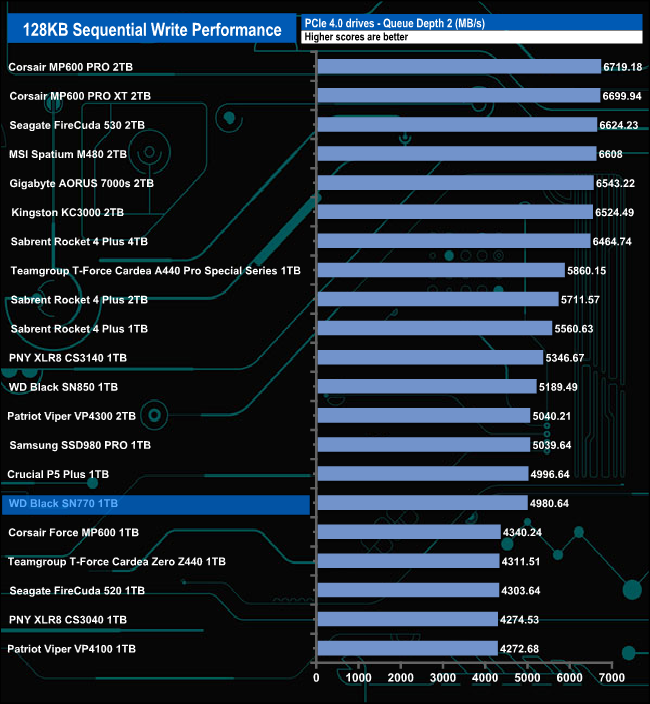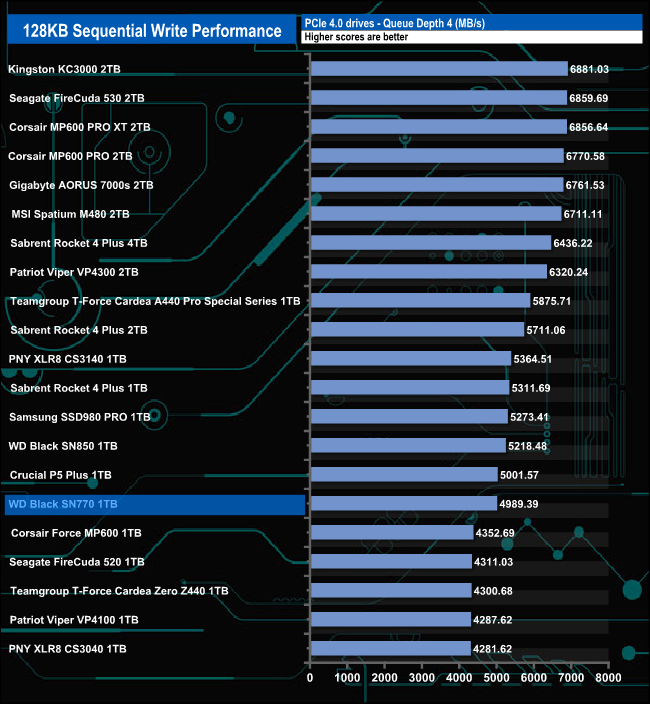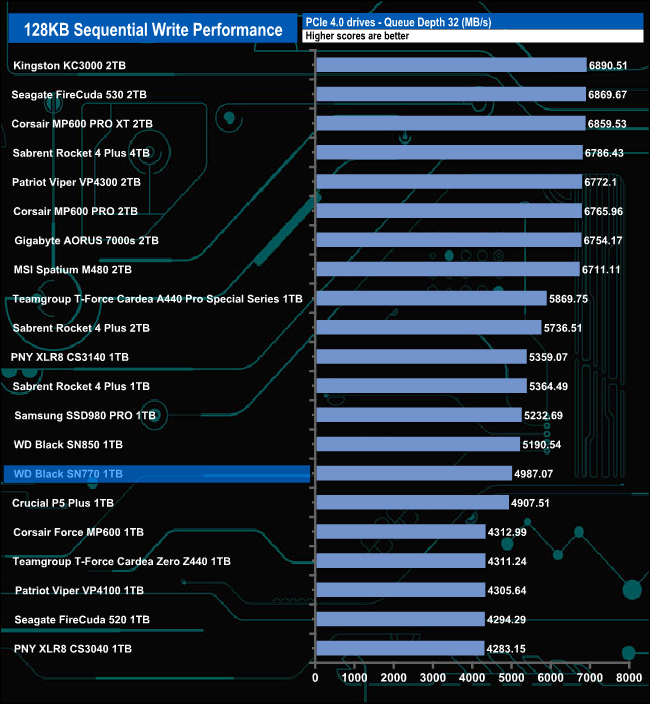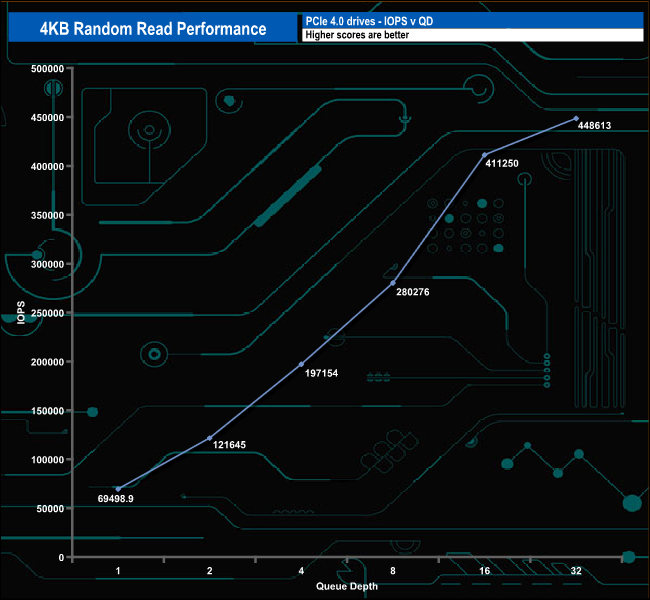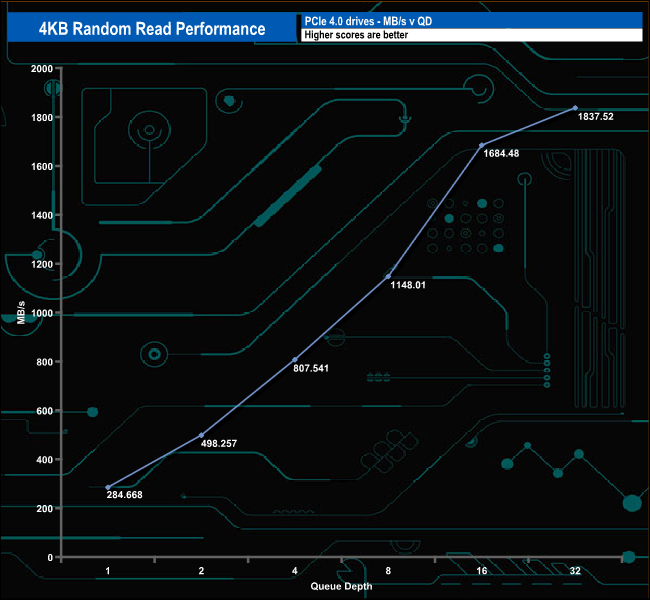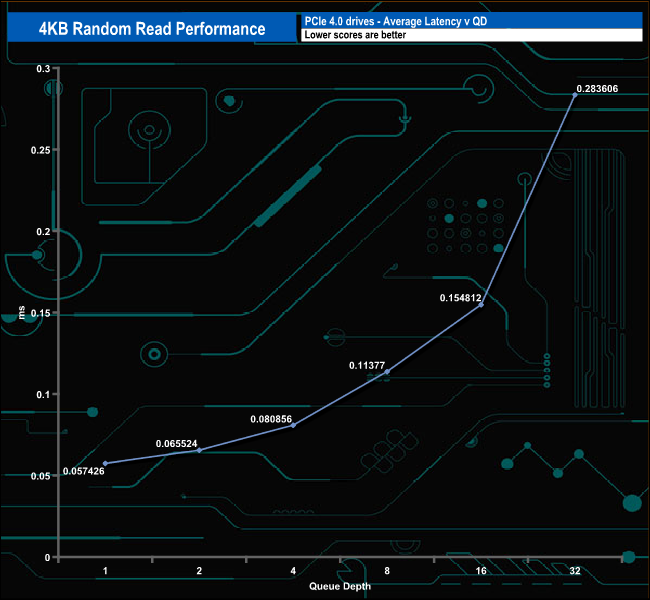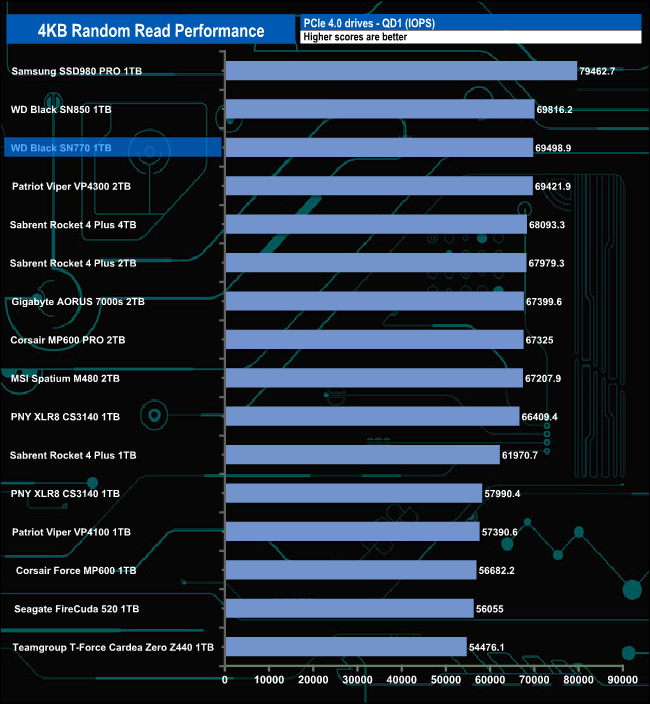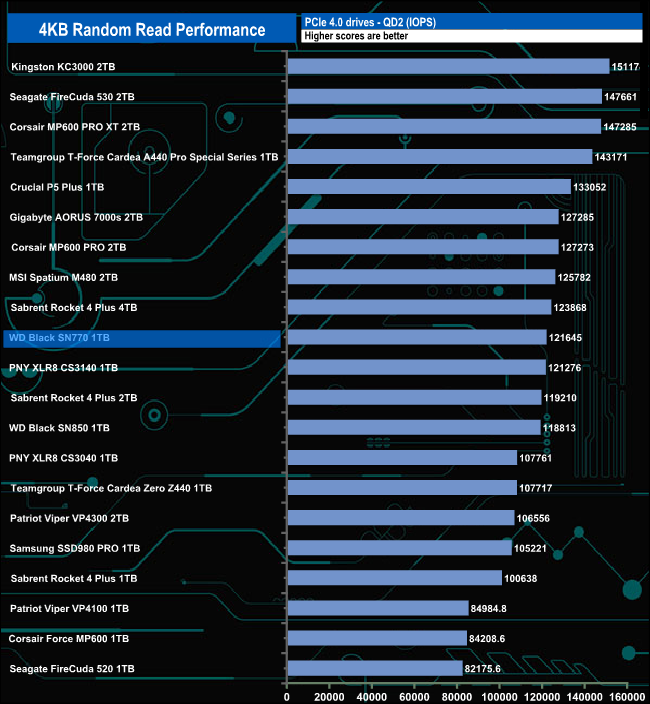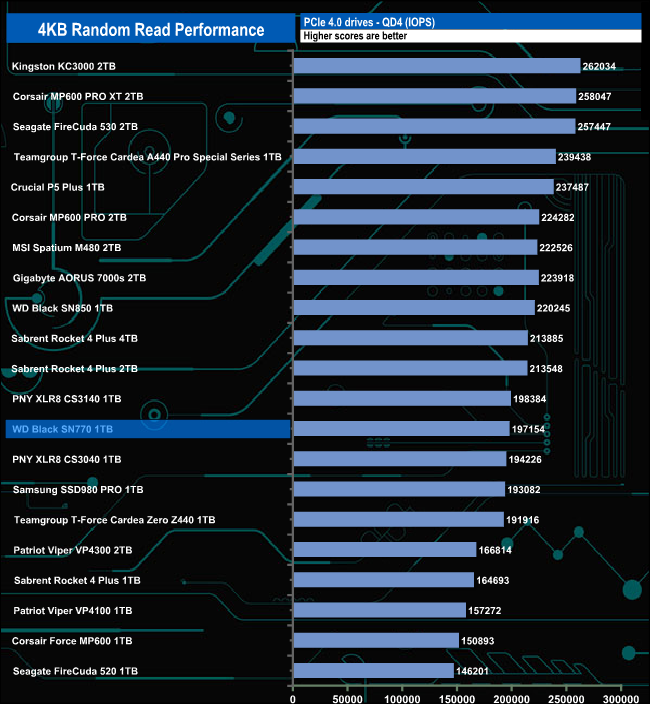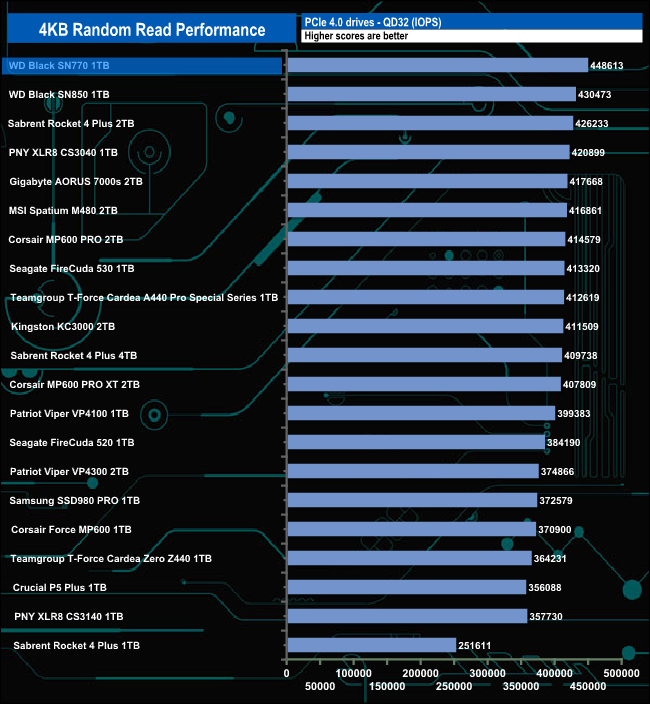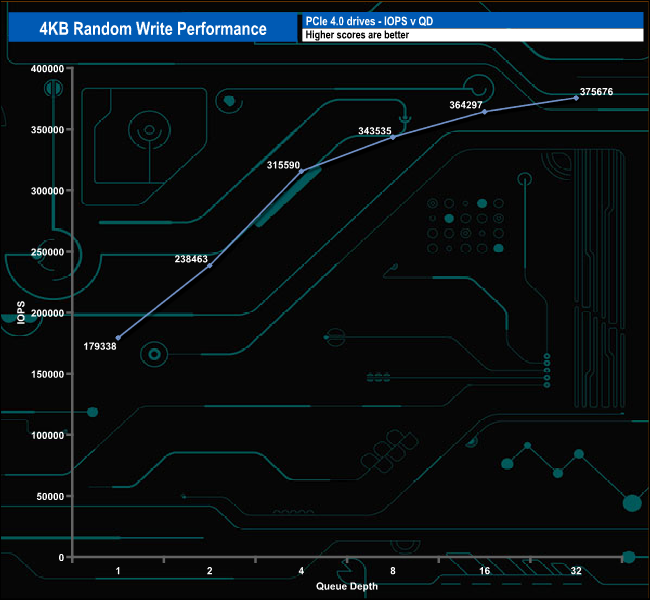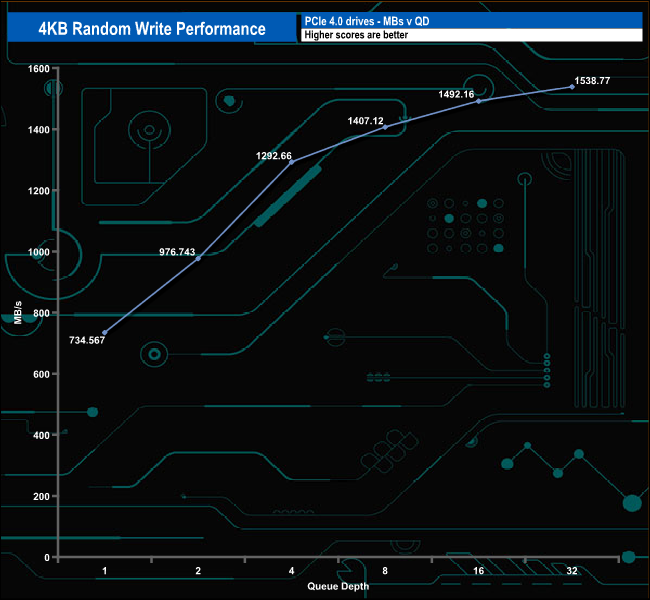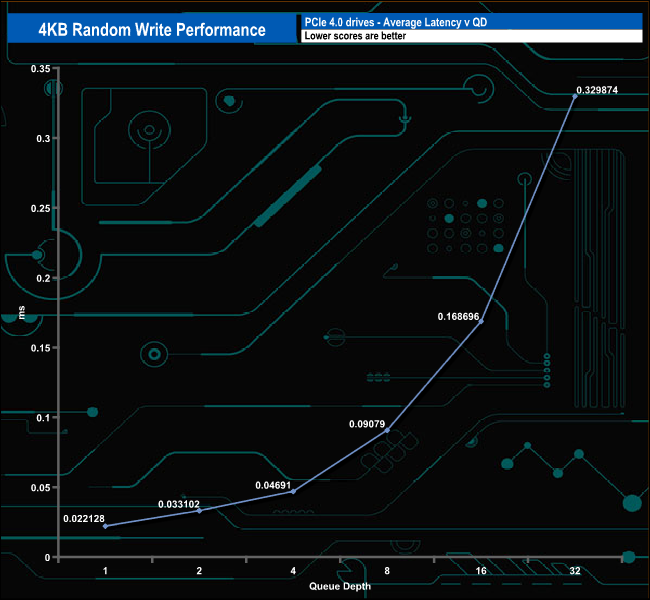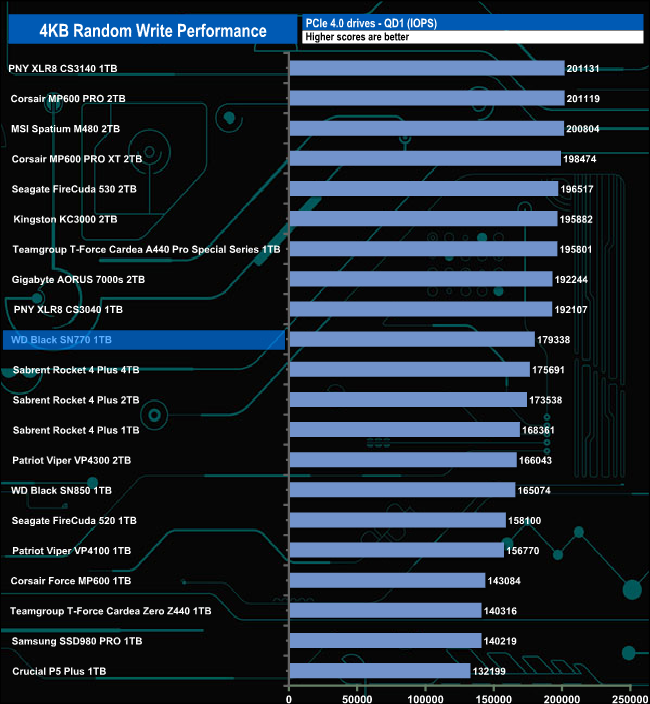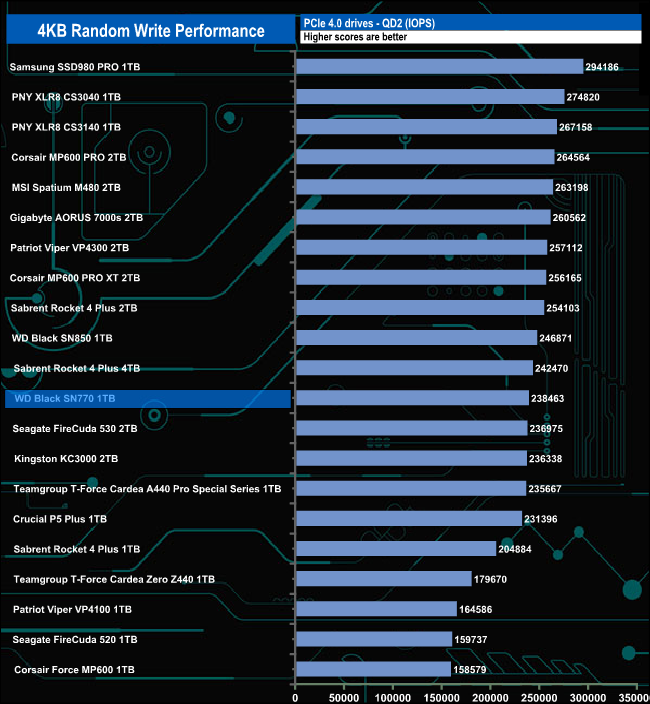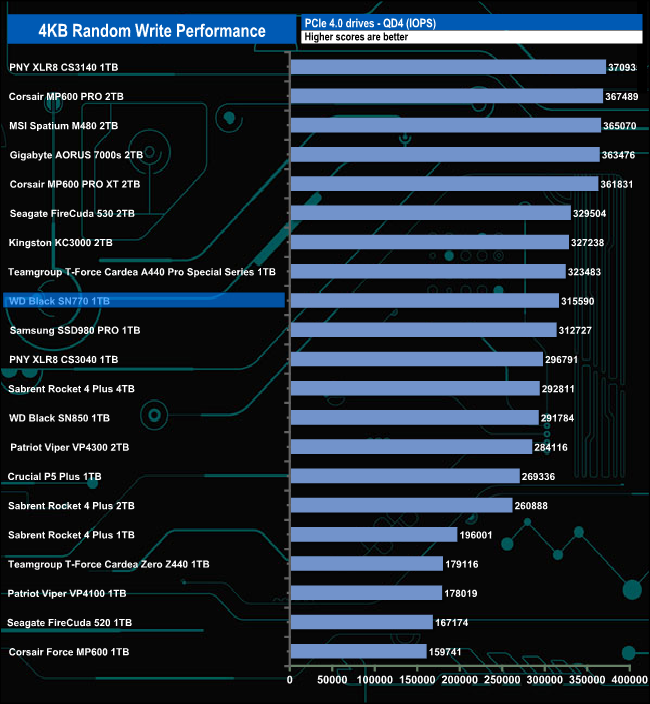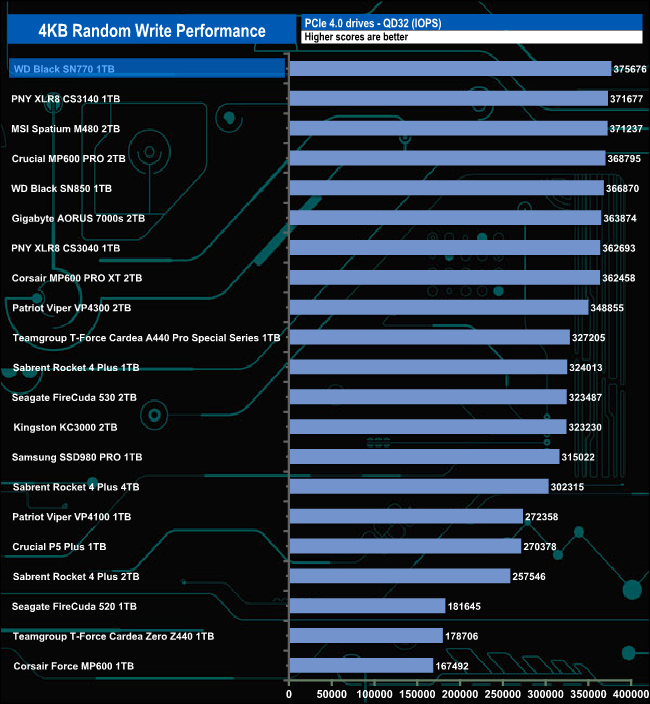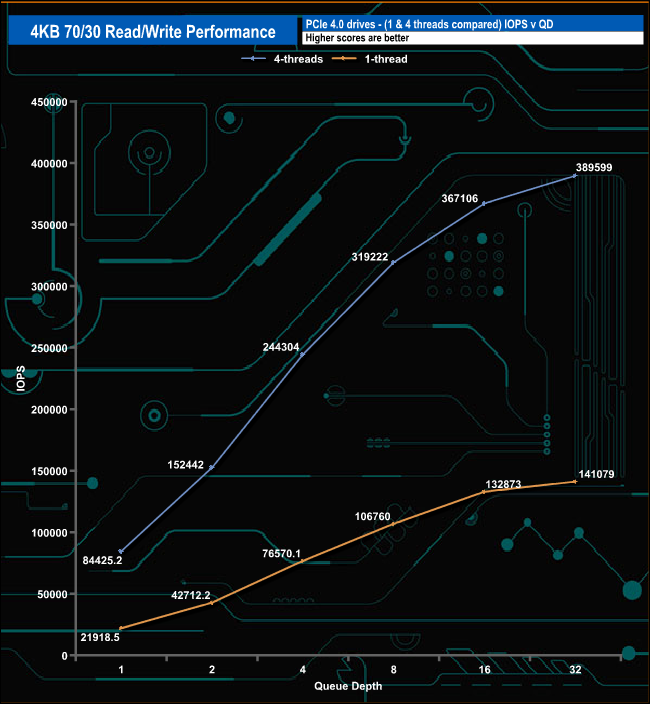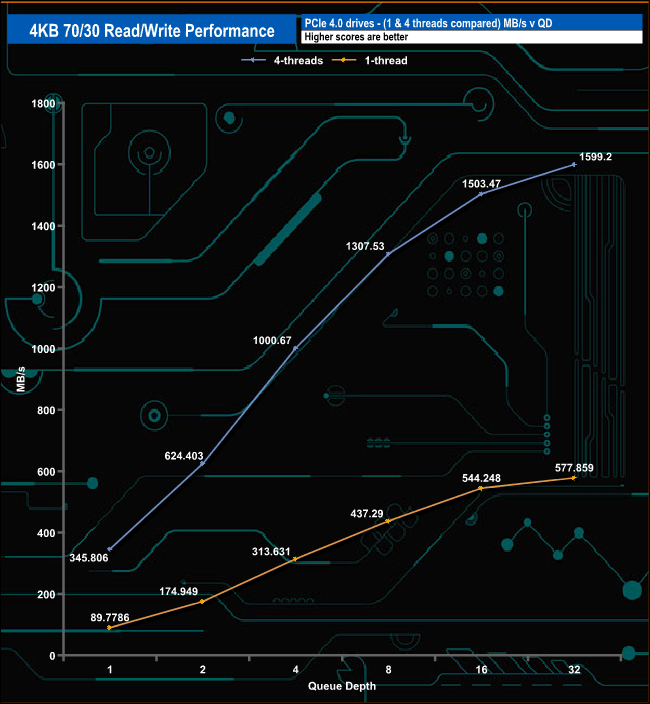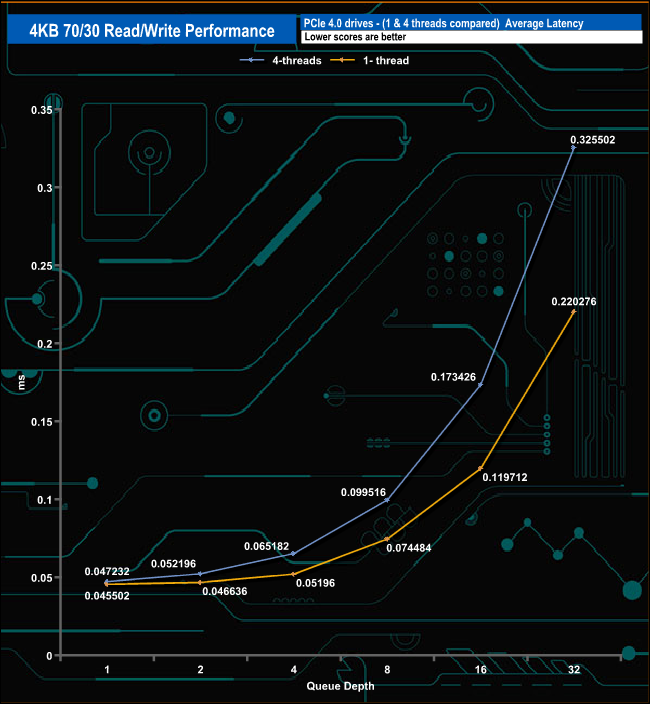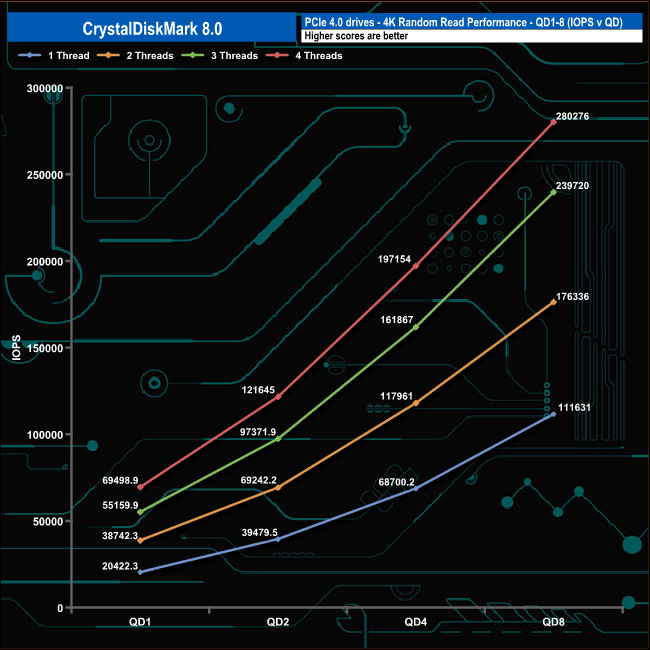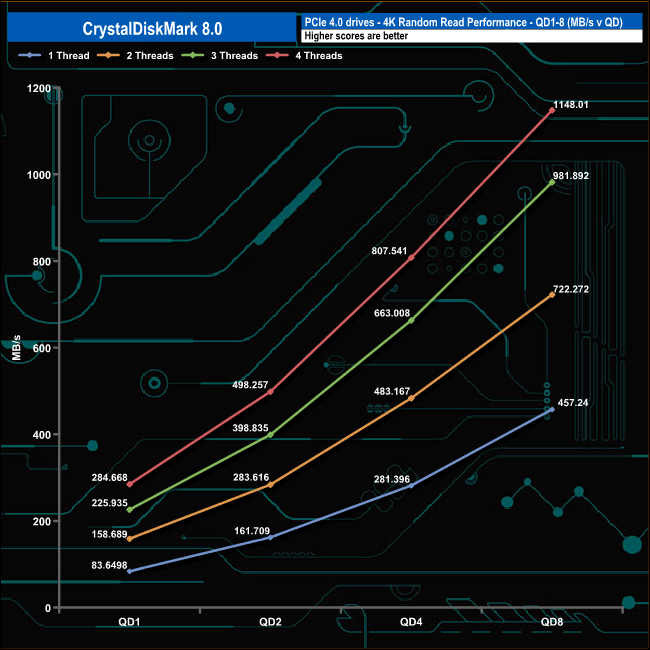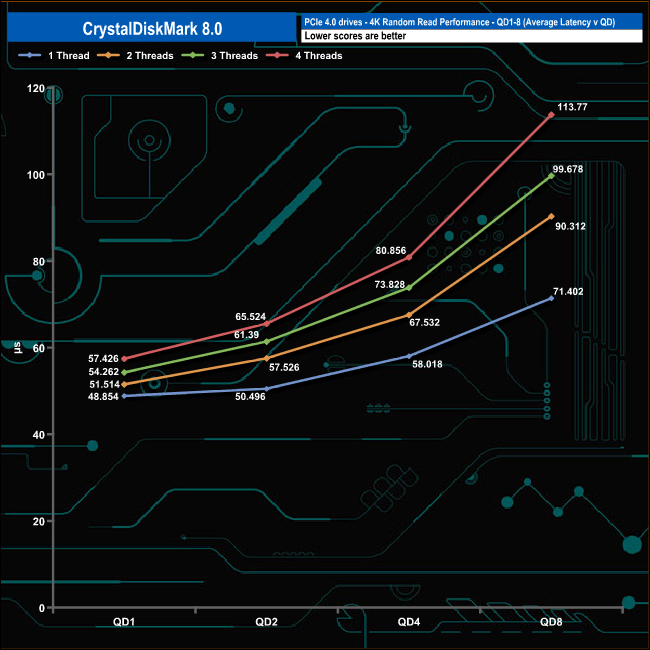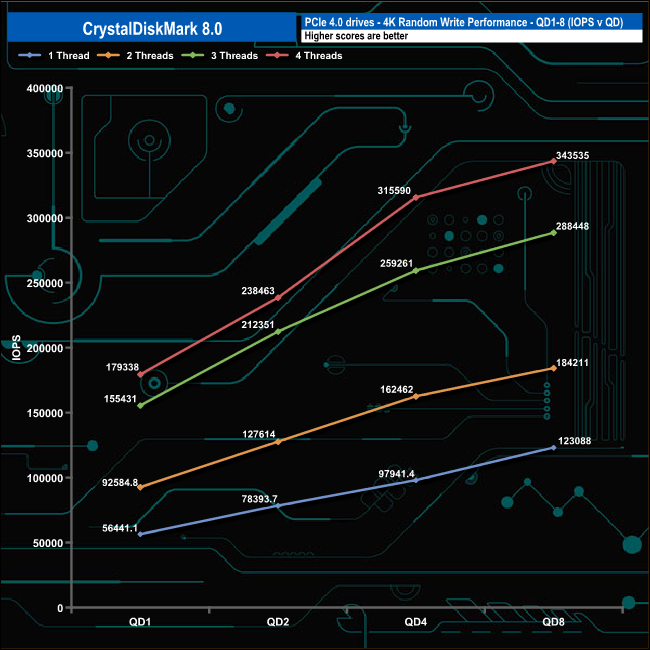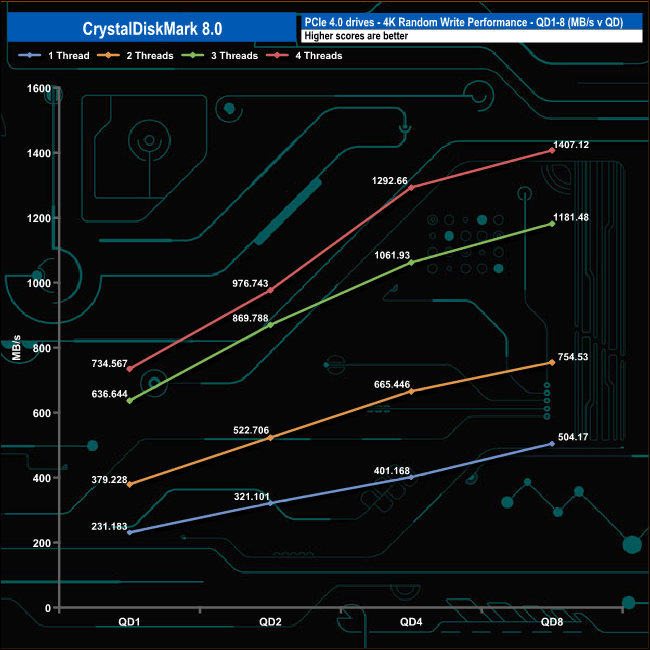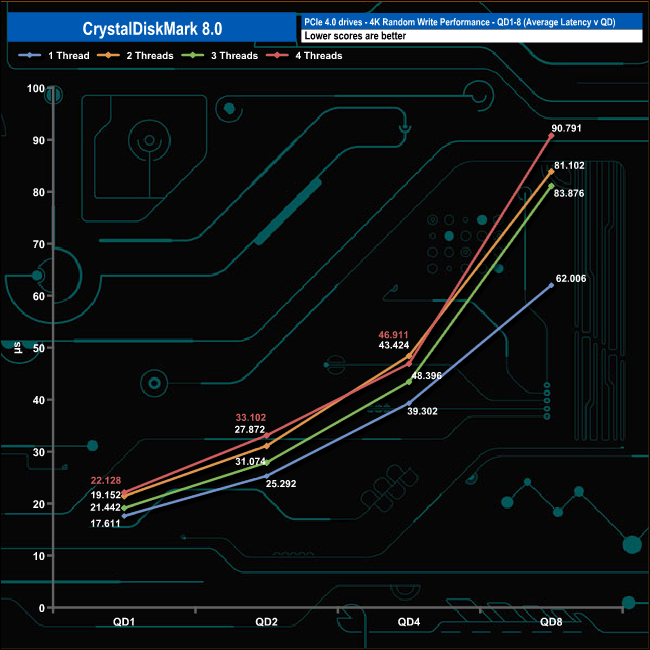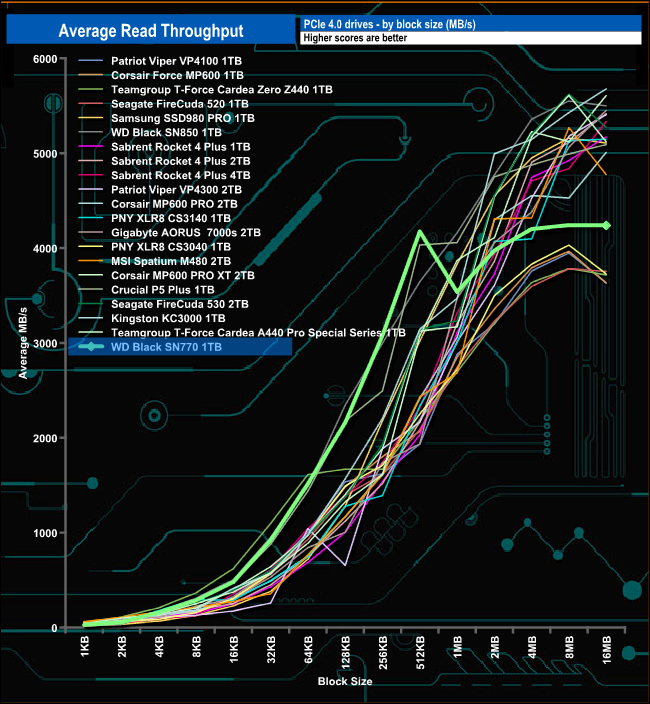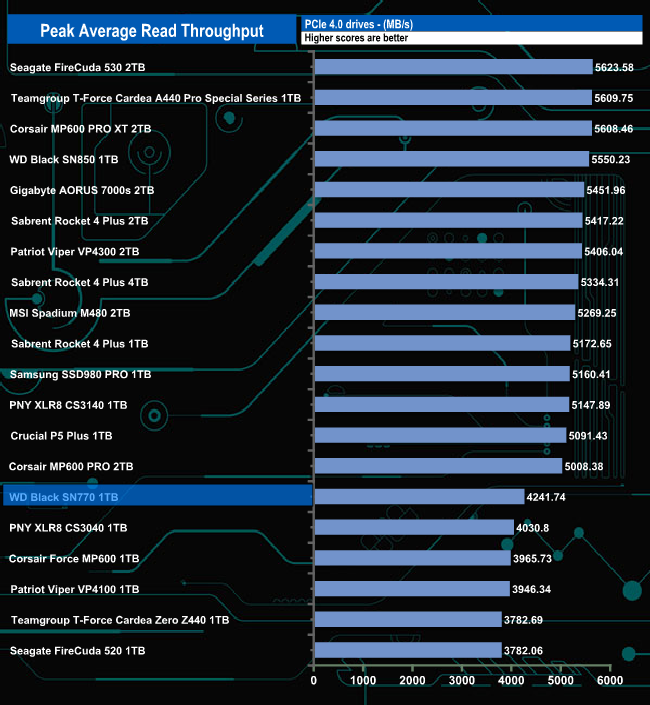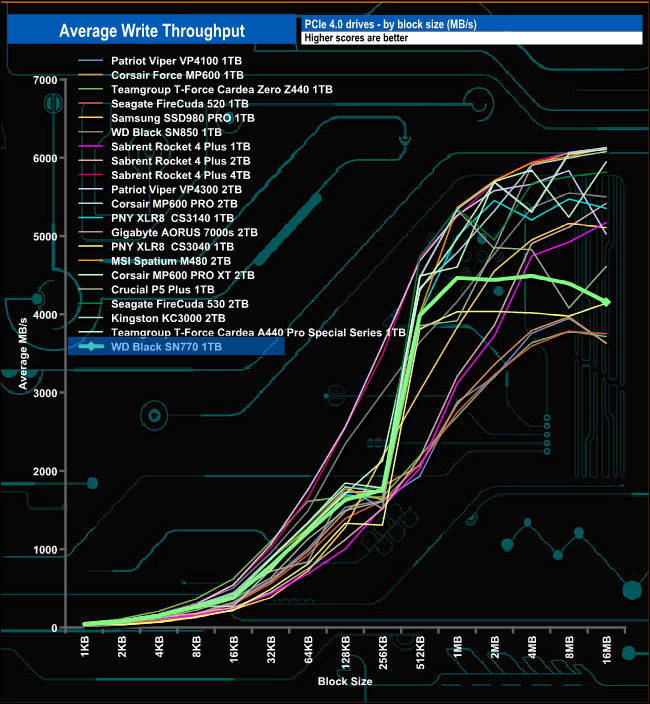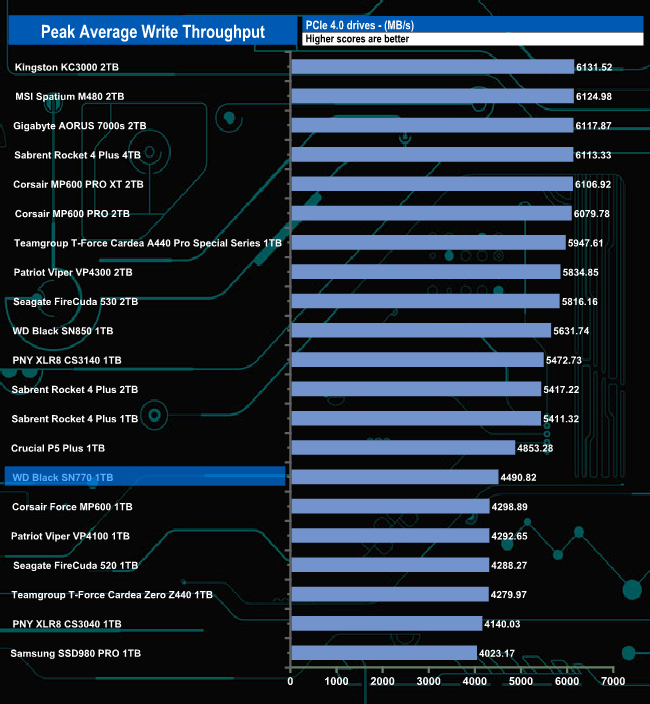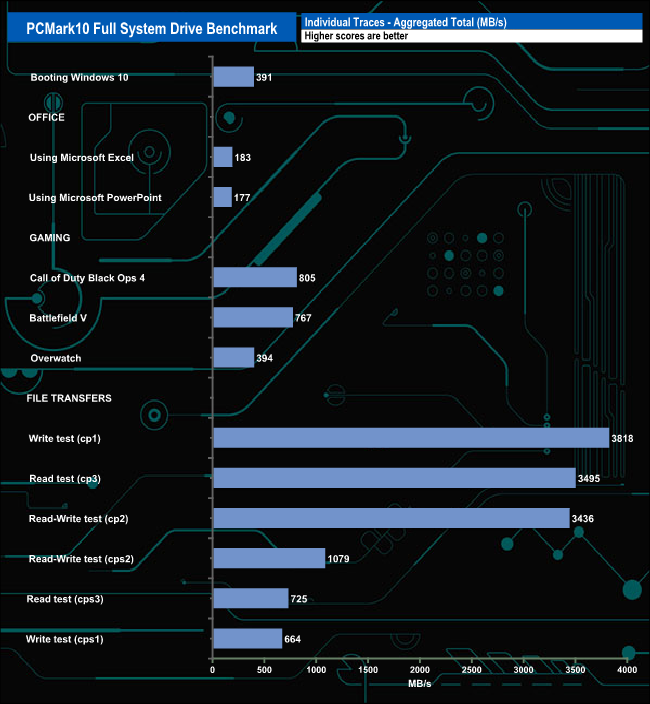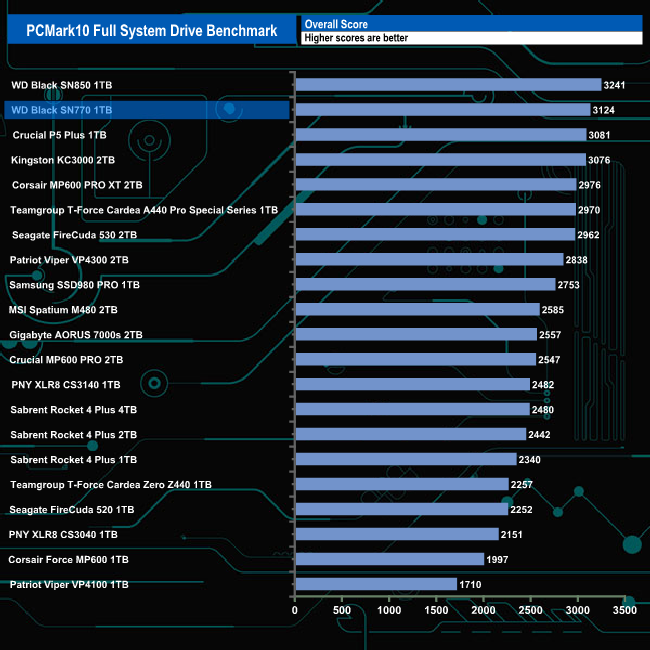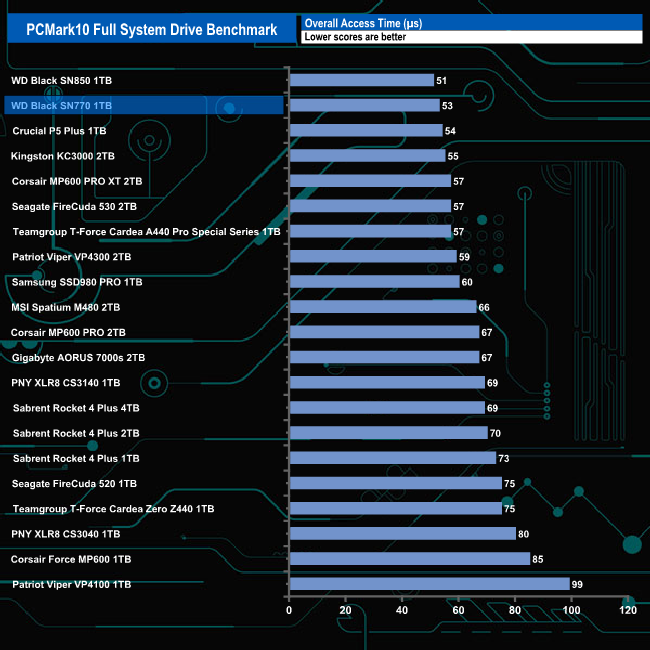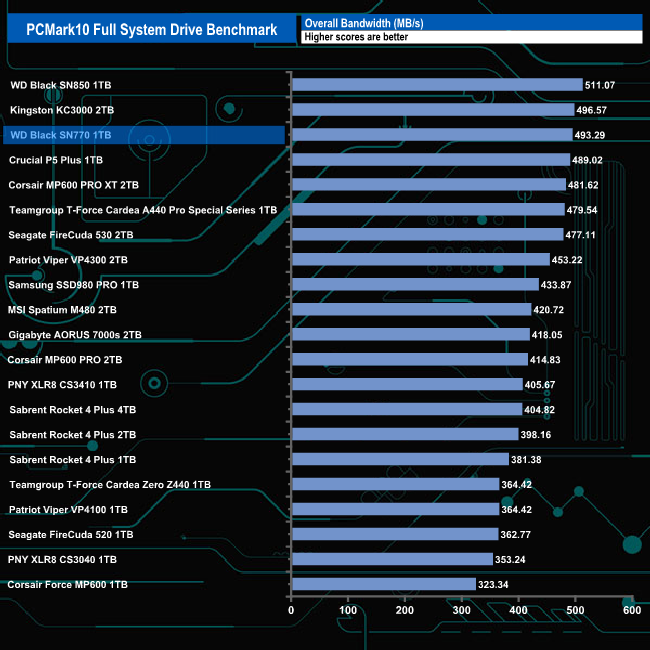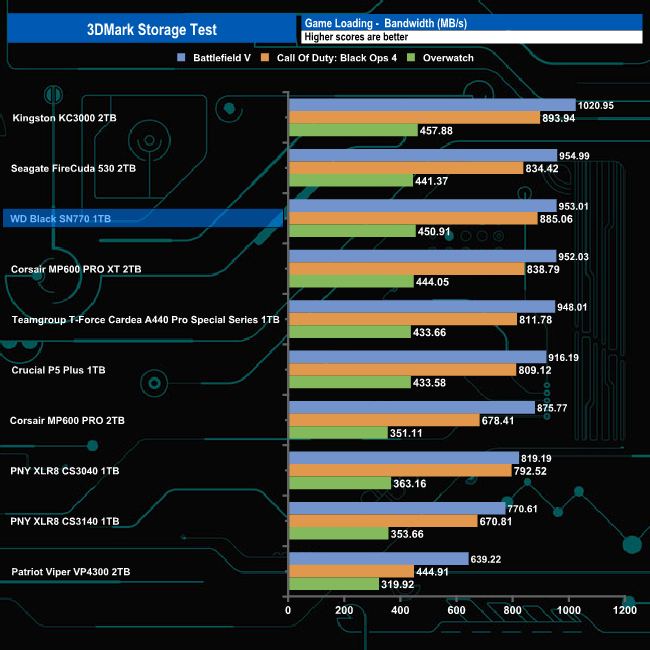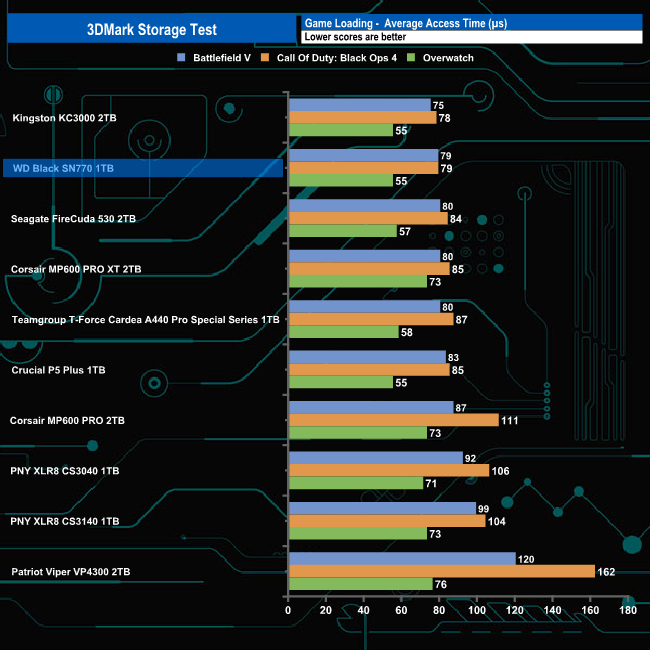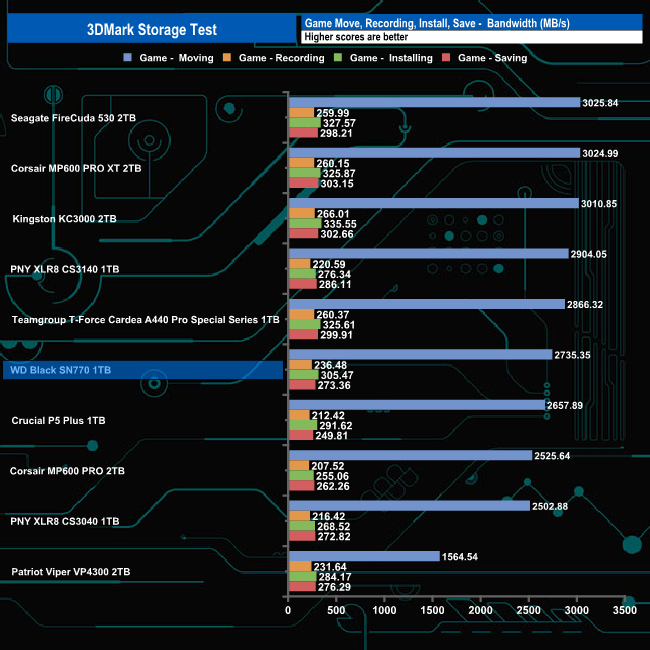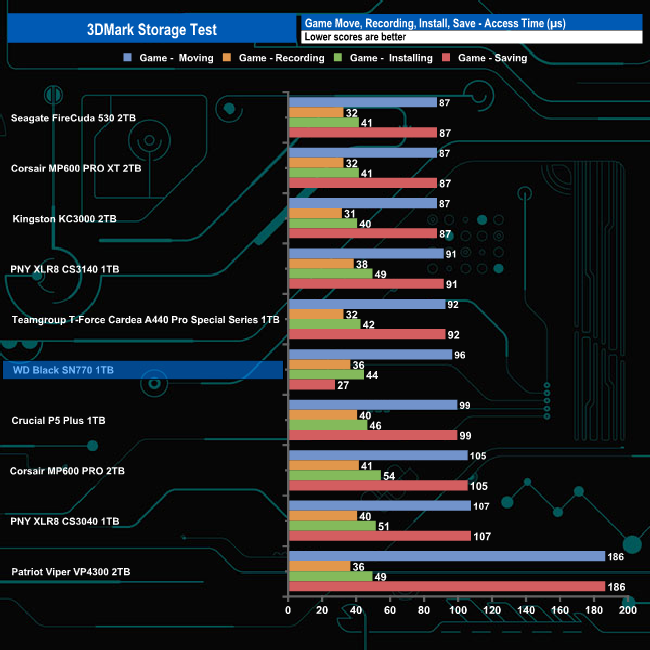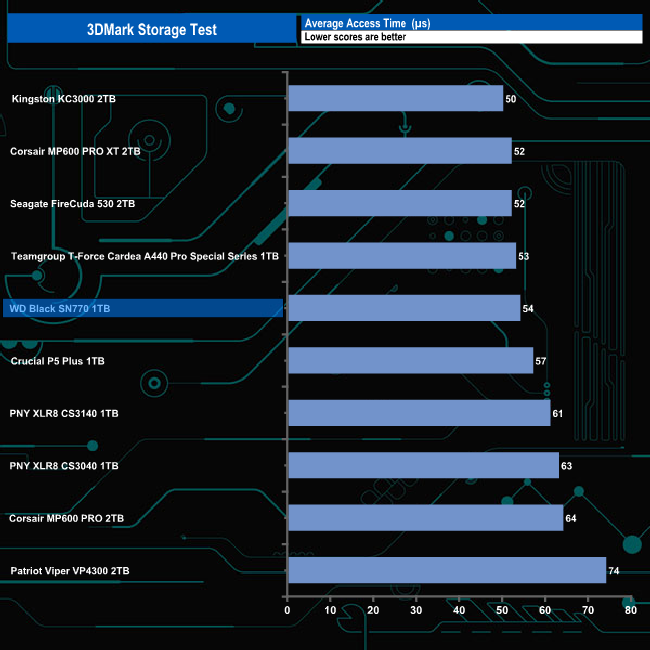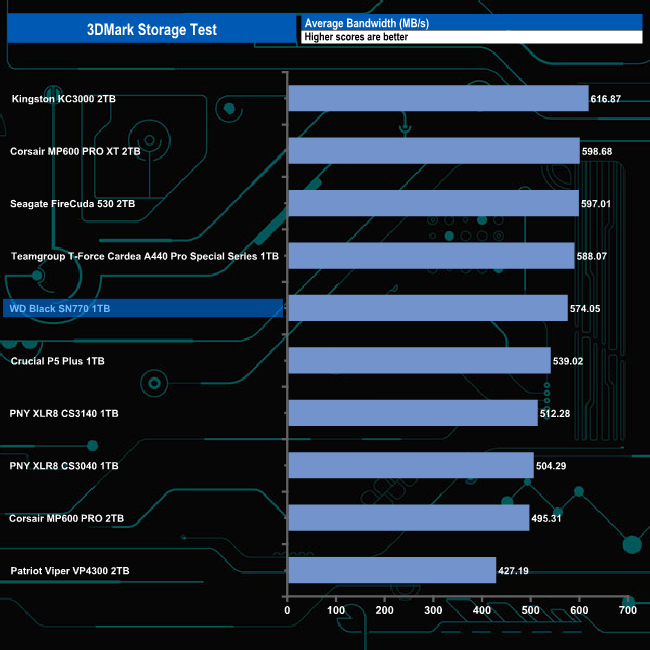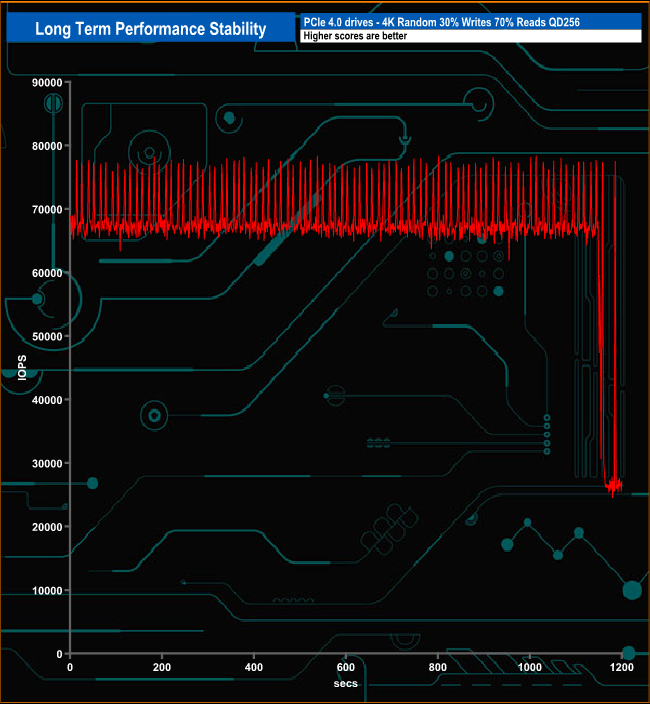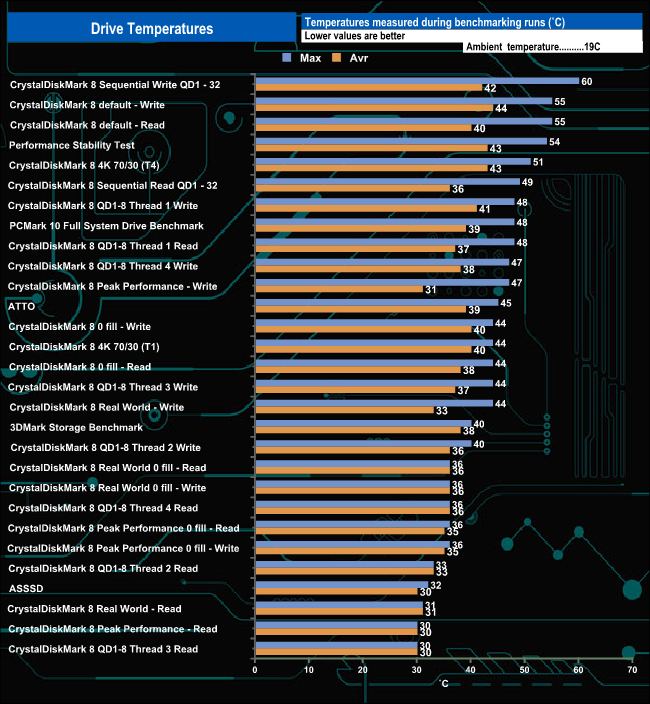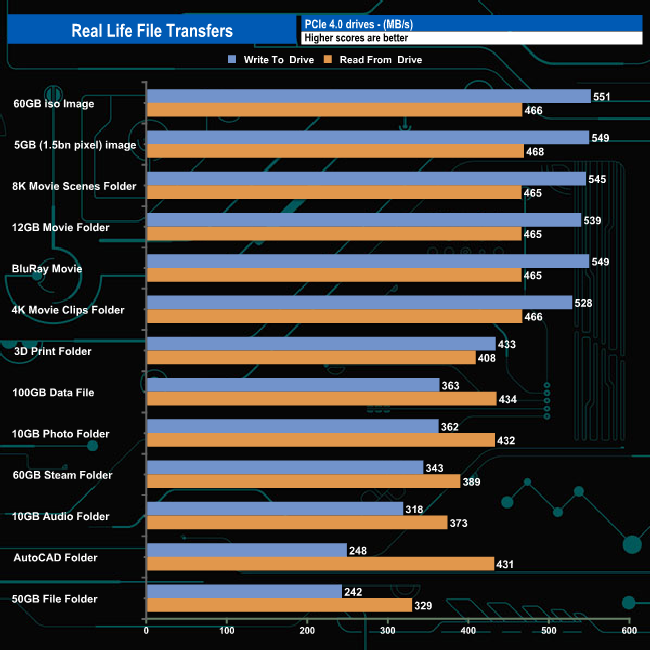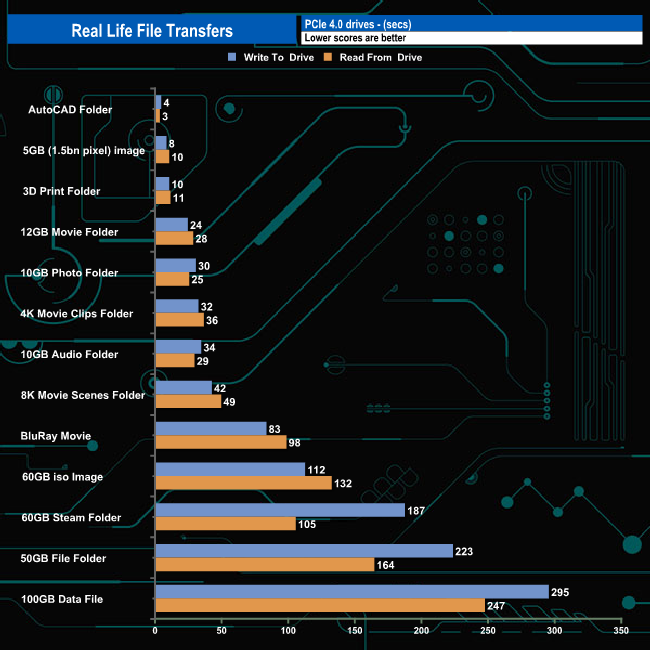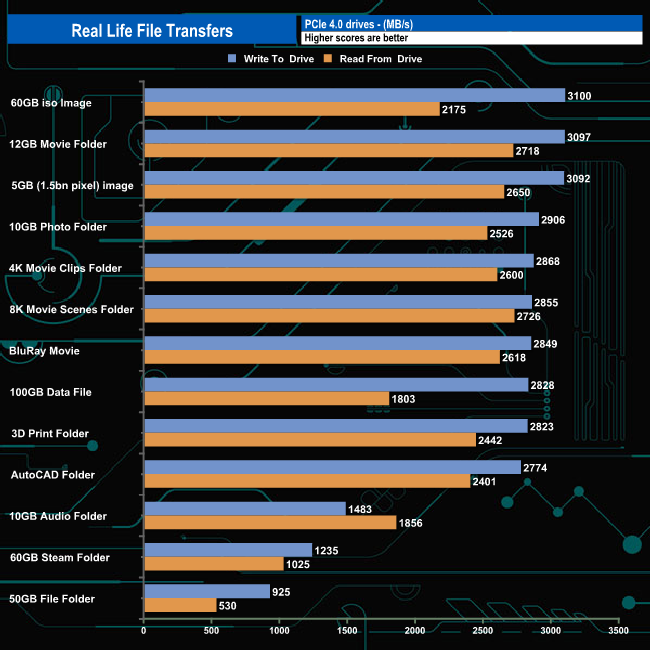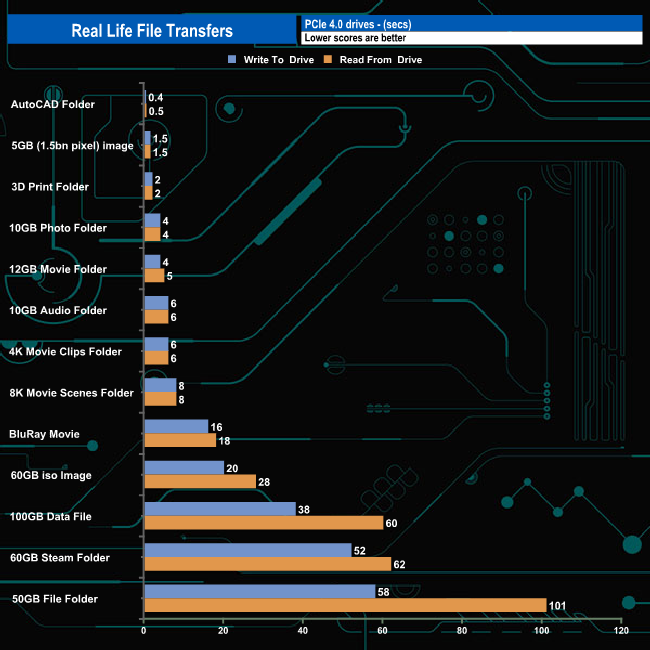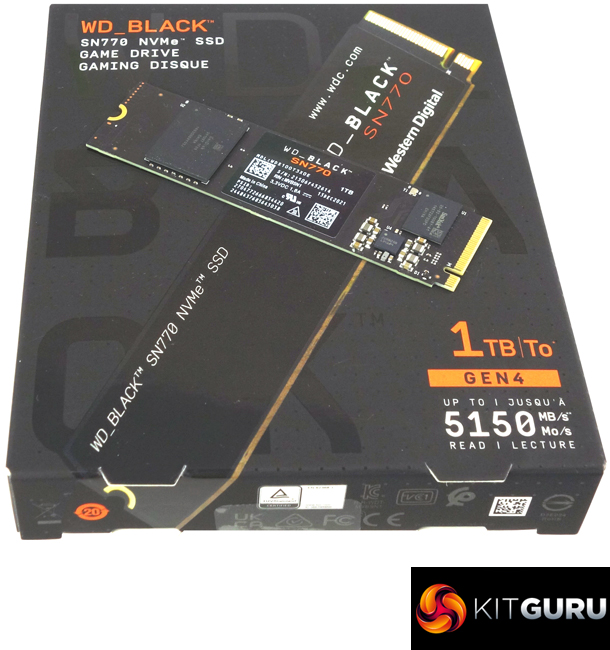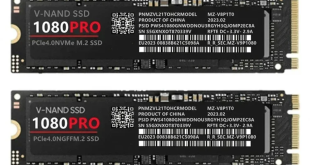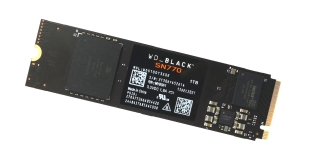
The latest addition to WD's Black gaming range of products is the Black SN770, a PCIe Gen 4 drive that uses a new controller and 112-layer TLC NAND. We put the 1TB model through its paces, priced at £142.99.
At launch, the WD Black SN770 range comprises four capacities; 250GB, 500GB, 1TB (the drive we are reviewing here) and the 2TB model. The drive uses a combination of a new 4-channel in-house controller, (details of which WD are keeping close to their chest) and 112-layer BiCS5 TLC NAND.
WD rate the 1TB drive for up to 5,150MB/s read and and up to 4,900MB/s write speeds. The 2TB model gets the same 5,150MB/s read figure with the 250GB and 500GB units rated at up to 4,000MB/s and 5,000MB/s respectively. As for sequential writes, the 2TB drive is quoted as up to 4,850MB/s, the 500GB model 4,000MB/s and the 250GB unit 2,000MB/s.
Random 4K performance is quoted as up to 740,000 IOPS and up to 800,000 IOPS for read and writes respectively for the 1TB Black SN770. The 500GB and 2TB drives get the same 800,000 IOPS write figure with the entry-level 250GB drive rated at up to 470,000 IOPS. The random 4K read ratings for the rest of the line-up are; 250GB 240,000 IOPS, 500GB 460,000 IOPS and 650,000 IOPS for the 2TB drive.
The endurance figure for the 1TB SN770 is 600TBW with the 250GB drive rated at 200TBW, the 500GB model 300TBW and 1200TBW for the 2TB drive. WD backs the drive range with a 5-year warranty.
Physical Specifications:
- Usable Capacities: 1TB.
- NAND Components: 112-layer BiCS5 TLC NAND.
- NAND Controller: WD 4-channel.
- Cache: none.
- Interface: PCIe 4 Gen 4.
- Form Factor: M.2, 2280
- Dimensions: 80 x 22 x 2.38mm.
- Weight: 5.5g.
Firmware Version: 731030WD
The WD Black SN770 comes in a smallish box with a clear image of the drive on the front. Under the image is the drive's capacity, the fact it's a Gen4 drive and the Sequential read performance figure (up to 5,150MB/s).
The rear of the box has a life-size image of the drive on the right-hand side while on the left is a very small English/French feature list. Between these two is a clear plastic panel through which part of the drive is visible, sitting in its protective plastic enclosure, next to which is a logo displaying the fact that the drive has a five-year warranty. The only other thing in the box is a Technical Support and Warranty Guide.
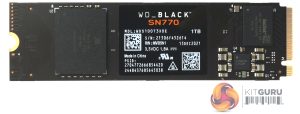
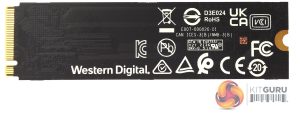
The 1TB Black SN770 is built on a single-sided M.2 2280 format. There's a lot of free space on the PCB as the major components consist of just a single BiCS5 112-layer TLC NAND package and a new 4-channel in-house controller (coded 20-82-10081-A1). WD is keeping details of the controller very close to their chest at the time of writing this review.
WD’s SSD management utility goes under the name of SSD Dashboard. With it, you can monitor drive status, performance, update firmware and monitor temperatures. There’s no cloning tool integrated into the utility but you can download Acronis True Image WD Edition from the WD website.
For testing, the drives are all wiped and reset to factory settings by HDDerase V4. We try to use free or easily available programs and some real world testing so you can compare our findings against your own system. This is a good way to measure potential upgrade benefits.
Main system:
AMD Ryzen 5 3600X, 16GB DDR4-2400, Sapphire R9 390 Nitro and an MSI MPG X570 Gaming Edge Wifi motherboard
Other drives
Corsair MP600 PRO 2TB
Corsair Force MP600 1TB
Corsair MP600 PRO XT 2TB
Crucial P5 Plus 1TB
Gigabyte AORUS 7000e 2TB
Kingston KC3000 2TB
MSI Spatium M480 2TB
Patriot Viper VP4300 2TB
Patriot Viper VPN4100 1TB
PNY XLR8 CS3040 1TB
PNY XLR8 CS3140 1TB
Sabrent Rocket 4 Plus 1TB
Sabrent Rocket 4 Plus 2TB
Sabrent Rocket 4 Plus 4TB
Samsung SSD980 PRO 1TB
Seagate FireCuda 520 1TB
Seagate FireCuda 530 2TB
Teamgroup T-Force Cardea Zero Z440 1TB
Teamgroup T-Force Cardea A440 Pro Special Series 1TB
WD Black SN850 1TB
Software:
Atto Disk Benchmark 4.
CrystalMark 7.0.0.
AS SSD 2.0.
IOMeter.
Futuremark PC Mark 10.
All our results were achieved by running each test five times with every configuration this ensures that any glitches are removed from the results. Trim is confirmed as running by typing fsutil behavior query disabledeletenotify into the command line. A r
CrystalDiskMark is a useful benchmark to measure theoretical performance levels of hard drives and SSDs. We are using v8.0.
Using the default CrystalBenchMark 8 benchmark we could confirm the official read/write maximums of 5,150MB/s and 4,900MB/s with test results of 5,227MB/s and 4,993MB/s for read and writes respectively.
Looking at both benchmark result screens it appears that the new WD controller doesn't have a preference for what type of data it's being asked to handle.
Using the 4K QD1 Thread 1 test produces a read score of 83.85MB/s which is strong enough to see the drive in third place in our results chart but its write score of 232MB/s isn't as strong.
When the drive was tested with the Peak Performance profile in CrystalDiskMark 8 we could again confirm the official maximum read/write Sequential ratings of 5,150MB/s and 4,900MB/s with a read result of 5,227MB/s (default) and a best write result of 4,990MB/s (0 fill).
The official random 4K ratings for the 1TB Black SN770 are up to 740,000 IOPS for reads and up to 800,000 IOPS for writes. We couldn't match either of these maximums with CrystalDiskMark's Peak Performance profile but with a best test result of 725,446 IOPS the read performance was much closer to the official maximum than the 604,317 IOPS write figure.
Using the Real World profile, the Sequential score of 4,628MB/s was good enough to see the Black SN770 at the top of the results table. However, its write result of 4,973MB/s wasn't nearly as strong when compared to drives around it in the results chart.
The ATTO Disk Benchmark performance measurement tool is compatible with Microsoft Windows. Measure your storage systems performance with various transfer sizes and test lengths for reads and writes. Several options are available to customize your performance measurement including queue depth, overlapped I/O and even a comparison mode with the option to run continuously. Use ATTO Disk Benchmark to test any manufacturers RAID controllers, storage controllers, host adapters, hard drives and SSD drives and notice that ATTO products will consistently provide the highest level of performance to your storage.
We are using version 4.0 for our NVMe disk tests.
The official Sequential read/write ratings for the 1TB Black SN770 are up to 5,150MB/s for reads and up to 4,900MB/s for writes. Using the ATTO benchmark we couldn't quite match those maximums with result figures of 4,880MB/s and 4,610MB/s for reads and writes respectively.
AS SSD is a great free tool designed just for benching Solid State Drives. It performs an array of sequential read and write tests, as well as random read and write tests with sequential access times over a portion of the drive. AS SSD includes a sub suite of benchmarks with various file pattern algorithms but this is difficult in trying to judge accurate performance figures.
With a read score of 2414 in the AS SSD benchmark, the drive is to be found near the bottom of the results chart but its write score of 2785 is pretty good.
We used CrystalDiskMark 8‘s custom settings to test the Sequential read and write performance of the drive through a range of queue depths. The setup for the tests is listed below.
128KB Sequential Read / Write.
Transfer Request Size: 128KB, Thread(s): 1, Outstanding I/O: 1-32.
In the 128KB Sequential read and write tests, the drive shows pretty consistent write performance from QD2 to the end of the test (QD32) confirming the official write figure of up to 4,900MB/s. When it comes to the read test runs there is a drop in performance at QD8 but the drive recovers quickly and it finishes the test run at 5,275MB/s, confirming WD's maximum read rating for the 1TB drive of 5,150MB/s.
128KB Sequential Read Performance v QD compared.
The 1TB Black SN770 performs best at lower queue depths when it comes to Sequential reads, being in the top three in QDs 1,2 and 4 but at QD32 it has sunk down to the bottom half of the results chart.
128KB Sequential Write Performance v QD compared.
In relation to the drives around it, the Black SN770's best Sequential write performance comes at QD1 where it sits mid chart. As the queue depth deepens it drops down the results chart.
We used CrystalDiskMark 8‘s custom settings to test the 4K random read performance of the drive through a range of queue depths. The setup for the tests is listed below.
Transfer Request Size: 4KB, Outstanding I/O: 1-32.
WD rate the 4K random read performance of the 1TB Black SN770 as up to 740,000 IOPS. Using our 4-threaded 4K random testing, the best we saw was 448,613 IOPS (QD32).
4K Random Read v QD Performance compared.
The WD Black SN770 performs well at both ends of our 4K random read tests. At QD1 it sits in third place (69,498 IOPS) and at QD32 it tops the chart (448,613 IOPS). However, the final figure of 448,613 IOPS is a long way short of the official maximum of 740,000 IOPS.
We used CrystalDiskMark 8‘s custom settings to test the 4K random write performance of the drive through a range of queue depths. The setup for the tests is listed below.
Transfer Request Size: 4KB, Outstanding I/O: 1-32.
In the random write test, the best test result we saw from the 1TB SN770 was 375,676 IOPS (QD32). which is nowhere near the official maximum of 800,000 IOPS. We did a quick test of the drive using eight threads and got a test result of 422,055 IOPS, still well short of the official figure.
4K Random Write v QD Performance.
The drive sits around mid-table in all the tested queue depths until it comes to the final QD32 test when, just like the random read test, the drive moves to the top of the chart.
We used CrystalDiskMark 8’s custom settings to test the 4K 70/30 mixed read/write performance of the drive through a range of queue depths using a single thread and four threads.
The WD Black SN770 has no problem dealing with our 70/30 read/write tests either using a single thread or with four threads. With a single thread, the drive produces 21,918.5 IOPS (89.778MB/s) at QD1 climbing to finish the test run at QD32 with 141,079 IOPS (577.859MB/s). Using four threads the drive climbs from 84,425.2 IOPS (345.806MB/s) at QD1 to 389,599 IOPS (1599.2MB/s) at QD32.
We used CrystalDiskMark 8 to test the random performance of the drive at lower queue depths (QD1 – QD8 where most of the everyday workloads occur) using 1 to 4 threads.
At QD1 the performance of the 1TB WD Black SN770 ranges from a low point of 20,422 IOPS (83MB/s) using a single thread up to 69,498 IOPS (284MB/s) using four threads. The performance increases steadily as the queue depth deepens for each thread count finishing at QD8 with figures ranging from 111,631 (457.24MB/s) for a single thread up to 280,276 IOPS (1,148MB/s) for four threads.
The WD Black SN770's write performance climbs smoothly throughout the tested queue depths and threads with a peak performance figure of 347,535 IOPS (1,407MB/s) at QD8 using four threads.
In our read throughput test, the 1TB Black SN770 peaked at 4,241.74MB/s at the 8MB block mark. That test result is some way off the official maximum of 5,150MB/s.
The peak read throughput test result of the Black SN770 sees it in the bottom half of our results chart.
Peak write throughput came at the 4MB block mark at 4,490MB/s, again slower than the official maximum figure of 4,900MB/s.
As with the read throughput test, the write test result sees the drive in the bottom half of the table.
The PCMark 10 Full System Drive Benchmark uses a wide-ranging set of real-world traces from popular applications and common tasks to fully test the performance of the fastest modern drives. The benchmark is designed to measure the performance of fast system drives using the SATA bus at the low end and devices connected via PCI Express at the high end.
The goal of the benchmark is to show meaningful real-world performance differences between fast storage technologies such as SATA, NVMe, and Intel’s Optane. The Full System Drive Benchmark uses 23 traces, running 3 passes with each trace. It typically takes an hour to run.
Traces used:
Booting Windows 10.
Adobe Acrobat – starting the application until usable.
Adobe Illustrator – starting the application until usable.
Adobe Premiere Pro – starting the application until usable.
Adobe Photoshop – starting the application until usable.
Battlefield V – starting the game until the main menu.
Call of Duty Black Ops 4 – starting the game until the main menu.
Overwatch – starting the game until the main menu.
Using Adobe After Effects.
Using Microsoft Excel.
Using Adobe Illustrator.
Using Adobe InDesign.
Using Microsoft PowerPoint.
Using Adobe Photoshop (heavy use).
Using Adobe Photoshop (light use).
cp1 Copying 4 ISO image files, 20 GB in total, from a secondary drive to the target drive (write test).
cp2 Making a copy of the ISO files (read-write test).
cp3 Copying the ISO to a secondary drive (read test).
cps1Copying 339 JPEG files, 2.37 GB in total, to the target drive (write test).
cps2 Making a copy of the JPEG files (read-write test).
cps3 Copying the JPEG files to another drive (read test).
The WD Black SN770 dealt with the rigours of the PCMark10’s Full System Drive pretty well. The best result from the Creative set of test traces was the 952MB/s for the Heavy Use Adobe Photoshop trace while the 497MB/s for the Adobe After Effects use trace is very good. The file transfer tests also produced a good cp1 (write test) figure of 3,818MB/s backed up by the 3,495MB/s for the cp3 (read test) and 3,436MB/s for the cp2 read/write test traces.
The overall bandwidth figure of 493.29MB/s sees the WD Black SN770 slip into third place in our result chart behind Kingston’s KC3000 and WD's other Gen4 drive, the SN850.
The 3DMark Storage Benchmark uses traces recorded from popular games and gaming-related activities to measure real-world gaming performance.
Traces used –
Battlefield V
Loading Battlefield™ V from launch to the main menu.
Call of Duty Black Ops 4
Loading Call of Duty®: Black Ops 4 from launch to the main menu.
Overwatch
Loading Overwatch® from launch to the main menu.
Game Move
Copying the Steam folder for Counter-Strike®: Global Offensive from an external SSD to the system drive.
Game Recording
Recording a 1080p gameplay video at 60 FPS with OBS (Open Broadcaster Software) while playing Overwatch®.
Installing Game
Installing The Outer Worlds® from the Epic Games Launcher.
Game Saving
Saving progress in The Outer Worlds game.
In 3DMark's Storage Test, the Black SN770 had an average bandwidth figure of 763MB/s for the three game load tests and an overall average bandwidth for the complete test run of 574.05MB/s.
For the long term performance stability test, we set the drive up to run a 20-minute 4K random test with a 30% write, 70% read split, at a Queue Depth of 256 over the entire disk. The 1TB WD Black SN770 averaged 67,223 IOPS for the test with a performance stability of 86%.
We took note of the drive’s temperature during some of our benchmarking runs. The WD Black SN770 doesn’t have a heatsink, but there is plenty of empty space on the PCB to allow air circulation around the components. The hottest the drive got was when it was being pushed very hard during the Sequential write test using CrystalDiskMark8, when it peaked at 60° C which is 25° C under the maximum operating temperature.
To test real life performance of a drive we use a mix of folder/file types and by using the FastCopy utility (which gives a time as well as MB/s result) we record the performance of drive reading from & writing to a 256GB Samsung SSD850 PRO.
Transfer details:
100GB data file.
60GB iso image.
60GB Steam folder – 29,521 files.
50GB File folder – 28,523 files.
12GB Movie folder – (15 files – 8 @ .MKV, 4 @ .MOV, 3 @ MP4).
10GB Photo folder – (304 files – 171 @ .RAW, 105 @ JPG, 21 @ .CR2, 5 @ .DNG).
10GB Audio folder – (1,483 files – 1479 @ MP3, 4 @ .FLAC files).
5GB (1.5bn pixel) photo.
BluRay Movie – 42GB.
21GB 8K Movie demos – (11 demos)
16GB 4K Raw Movie Clips – (9 MP4V files).
4.25GB 3D Printer File Folder – (166 files – 105 @ .STL, 38 @ .FBX, 11 @ .blend, 5 @ .lwo, 4 @ .OBJ, 3@ .3ds).
1.5GB AutoCAD File Folder (80 files – 60 @ .DWG and 20 @.DXF).
The drive was pretty consistent when dealing with the larger file transfers in our real-life file transfer tests averaging 543.5MB/s writing six of the largest folders to the drive and 465MB/s when reading them back. The fastest transfer was for the 60GB iso image (551MB/s) with the slowest being the 50GB file folder transfer at 242MB/s.
To get a measure of how much faster PCIe NVMe drives are than standard SATA SSD's we use the same files but transfer to and from a 2TB Kioxia Exceria Plus drive:
Swapping over to an all NVMe architecture saw transfer speeds rocket as you might expect. Three of the write transfers topped 3GB/s; 60GB iso 3,100MB/s, 12GB Movie Folder 3,097MB/s and the 5GB (1.5bn pixel) image. 3,092MB/s. Seven more topped 2.5GB/s while the slowest was the 50GB file folder with 925MB/s writing and 530MB/s reading.
It was at the end of 2020 when we last looked at a WD PCIe Gen4 drive, the Black SN850, but now we have the latest one to hand, the Black SN770.
Aimed at gamers, the new drive uses a new in-house WD 4-channel controller combined with 112-layer BiCS5 flash. WD is keeping details of the new controller close to their chest but it comes in a tiny package measuring just 11 x 7mm.
The Black SN770 line-up at launch consists of four capacities; 250GB, 500GB, 1TB (the drive we are looking at here) and a 2TB flagship drive. The layout of the 1TB drive looks much the same as the last WD drive we reviewed, the Blue SN570, as in all the major components (controller and NAND package) sit at either end of the PCB with nothing in between them.
Official Sequential ratings for the 1TB drive are up to 5,100MB/s for reads with writes at up to 4,900MB/s. When benchmarked with the ATTO benchmark we couldn’t quite hit the official maximums, the drive producing a read figure of 4,880MB/s with writes at 4,610MB/s. However, with CrystalDiskMark we could confirm both figures with best test results of 5,228MB/s for reads and 4,994MB/s for writes.
When it comes to 4K random performance, WD quote figures of up to 740,000 IOPS and up to 800,000 IOPS for read and writes respectively. With our standard 4-threaded tests we saw a best of 448,613 IOPS (QD32) for reads and 375,676 IOPS for writes also at QD32. However, using the Peak Performance profile in CrystalDiskMark 8 we got a lot closer to the official figures with test results of 725,446 IOPS for reads and 606,000 IOPS for writes.
In terms of endurance, the 1TB SN770 is rated at 600TBW while the 250GB drive is rated at 200TBW, the 500GB model 300TBW and 1200TBW for the 2TB drive. WD backs the drive range with a 5-year warranty.
WD's latest PCIe Gen4 drive is a good all-around drive but the fly in the ointment is the pricing. The 1TB drive has an MSRP of £142.99, but the trouble is the standard 1TB Black SN850 is only £11 more on WD's own website.
We don't yet have a buy link but the MSRP for the new 1TB WD Black SN770 is £142.99.
Discuss on our Facebook page HERE.
Pros
- Overall performance.
- 5-year warranty.
Cons
- Couldn’t match the official maximum 4K random write figures in some of our testing.
KitGuru says: It's taken a while for WD to launch another Gen4 drive into the market, but with the Black SN770 WD has introduced a new controller which is used in combination with BiCS5 TLC NAND to good effect. But the 1TB Gen4 market space is highly competitive and the price could do with a little trimming.
Be sure to check out our sponsors store EKWB here
 KitGuru KitGuru.net – Tech News | Hardware News | Hardware Reviews | IOS | Mobile | Gaming | Graphics Cards
KitGuru KitGuru.net – Tech News | Hardware News | Hardware Reviews | IOS | Mobile | Gaming | Graphics Cards


